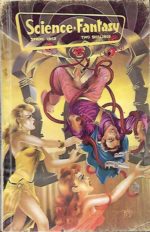 *DC: One of my all-time favourite comics! While all early issues of Hawkman are superb, with high-flying sci-fi stories by Gardner Fox and luminous Murphy Anderson artwork (not that we’re prejudiced witnesses or anything…), the most sought-after in recent years is issue #4, featuring the debut of the Princess of Prestidigitation – Zatanna! Zee (as she’s familiarly known), a personal favourite here at 30th Century, is the daughter of DC’s Golden Age magician Zatara, and took her quest for her missing father through the pages of Green Lantern, Atom, Detective Comics and the Justice League of America in one of DC’s earliest ‘story arcs’, but this is where her illustrious career – which has branched out into both animated and live-action TV – began. (And yes, they did miss a bet by not having her featured on the cover – foolish mortals!). We’ve had a few copies of this through our hands in the past year or two, but this is by far the loveliest copy, tight and flat with firm staples, great cover colour and gloss, nice just off-white pages and virtually no edge wear. There’s one very faint crease (not colour breaking) below the ‘H’ in the logo and an almost invisible, very shallow crease at an angle up from the lower edge, but you have to look really hard to see it. I’ll let you in on a secret — this copy is even nicer than my personal copy and would be in my collection like a shot (except that my copy was signed by Murphy Anderson when I met him and his wife many years ago and remains one of my most treasured possessions). High resolution images are available on request.
*DC: One of my all-time favourite comics! While all early issues of Hawkman are superb, with high-flying sci-fi stories by Gardner Fox and luminous Murphy Anderson artwork (not that we’re prejudiced witnesses or anything…), the most sought-after in recent years is issue #4, featuring the debut of the Princess of Prestidigitation – Zatanna! Zee (as she’s familiarly known), a personal favourite here at 30th Century, is the daughter of DC’s Golden Age magician Zatara, and took her quest for her missing father through the pages of Green Lantern, Atom, Detective Comics and the Justice League of America in one of DC’s earliest ‘story arcs’, but this is where her illustrious career – which has branched out into both animated and live-action TV – began. (And yes, they did miss a bet by not having her featured on the cover – foolish mortals!). We’ve had a few copies of this through our hands in the past year or two, but this is by far the loveliest copy, tight and flat with firm staples, great cover colour and gloss, nice just off-white pages and virtually no edge wear. There’s one very faint crease (not colour breaking) below the ‘H’ in the logo and an almost invisible, very shallow crease at an angle up from the lower edge, but you have to look really hard to see it. I’ll let you in on a secret — this copy is even nicer than my personal copy and would be in my collection like a shot (except that my copy was signed by Murphy Anderson when I met him and his wife many years ago and remains one of my most treasured possessions). High resolution images are available on request.
PICTURED: HAWKMAN #4 FN/VF p £500
American Update: Iron Man #9 with the Hulk

 *Marvel: In issue #9 of his own series, Iron Man faces off against the Hulk (or does he? You’ll have to read it to find out) as arranged by the Mandarin. George Tuska’s art, as inked here by EC alumnus Jonny Craig, has seldom looked better. This is a lovely Square Mile specimen, tight, flat, sharp, glossy and reflective, with just the tiniest nick to the right edge preventing an even high grade. White pages and firm staples.
*Marvel: In issue #9 of his own series, Iron Man faces off against the Hulk (or does he? You’ll have to read it to find out) as arranged by the Mandarin. George Tuska’s art, as inked here by EC alumnus Jonny Craig, has seldom looked better. This is a lovely Square Mile specimen, tight, flat, sharp, glossy and reflective, with just the tiniest nick to the right edge preventing an even high grade. White pages and firm staples.
PICTURED: IRON MAN #9 VF p £80
American Update: Batmania/DC Debuts: 1st Batgirl in Detective Comics #359 (Poor)
 *DC: After the original Bat-Girl was swept away out of continuity with her aunt Batwoman following a change of direction for Batman in the 1960s, a new Batgirl was introduced, co-created by DC and the producers of the hit Batman TV show, as a boost to the third series of that iconic series. Barbara Gordon proved a hit as Batgirl both in comics and TV. Her comic debut came in Detective Comics #359, (1967) where she tangled with Killer Moth, just as she did in the pilot for her debut on TV. Barbara Gordon, amidst a history of adventure and misfortune, has gone on to become a mainstay of the DCU to this day. This copy of her debut has been removed from a bound volume and thus has a very tatty spine, split almost all the way and barely hanging on to the comic. It has also been trimmed at top and right edge to fit the volume (although this does not impact on the content) and there is also a small water stain at the bottom of the spine. Having said that, the cover image is unspoilt with good colour and some gloss, and decent off-white pages; it presents fairly well. Centrefold off bottom staple. A chance to obtain a big key issue at a very cheap price!
*DC: After the original Bat-Girl was swept away out of continuity with her aunt Batwoman following a change of direction for Batman in the 1960s, a new Batgirl was introduced, co-created by DC and the producers of the hit Batman TV show, as a boost to the third series of that iconic series. Barbara Gordon proved a hit as Batgirl both in comics and TV. Her comic debut came in Detective Comics #359, (1967) where she tangled with Killer Moth, just as she did in the pilot for her debut on TV. Barbara Gordon, amidst a history of adventure and misfortune, has gone on to become a mainstay of the DCU to this day. This copy of her debut has been removed from a bound volume and thus has a very tatty spine, split almost all the way and barely hanging on to the comic. It has also been trimmed at top and right edge to fit the volume (although this does not impact on the content) and there is also a small water stain at the bottom of the spine. Having said that, the cover image is unspoilt with good colour and some gloss, and decent off-white pages; it presents fairly well. Centrefold off bottom staple. A chance to obtain a big key issue at a very cheap price!
PICTURED: DETECTIVE COMICS #359 PR £55 SOLD
American Update: Batmania Bonus: Near complete run of Batman #301-350
 *DC: A near complete consecutive run of the main Batman title from #301-350 (with just a handful missing). Lots of Batman’s friends and foes represented in these issues, including the Black Spider, Mr. Freeze, Blockbuster, the Gentleman Ghost, Dr. Phosphorus, Batgirl, the Calendar Man, Two-Face, Robin, Riddler, Firebug, Joker, Captain Boomerang, lots and lots of Catwoman, Ra’s al Ghul and his daughter Talia, Poison Ivy, Man Bat and many more. Mostly in nice grades, averaging VF. Full details as always in our catalogue.
*DC: A near complete consecutive run of the main Batman title from #301-350 (with just a handful missing). Lots of Batman’s friends and foes represented in these issues, including the Black Spider, Mr. Freeze, Blockbuster, the Gentleman Ghost, Dr. Phosphorus, Batgirl, the Calendar Man, Two-Face, Robin, Riddler, Firebug, Joker, Captain Boomerang, lots and lots of Catwoman, Ra’s al Ghul and his daughter Talia, Poison Ivy, Man Bat and many more. Mostly in nice grades, averaging VF. Full details as always in our catalogue.
American Update: Spider-Mania Max/Slab Happy: Amazing Spider-Man #121 & #122 – Deaths of Gwen Stacy & Green Goblin

 *Marvel: This week’s entries in our Spider-Mania Max event are led by two CGC beauties, two of the most sought after of web-head’s adventures. Amazing Spider-Man #121 with the death of Gwen Stacy, is CGC 9.0 (blue label) and #122, the second part of the story with the death of the Green Goblin, is CGC 9.4 (also blue label). This storyline from 1973 came right out of the blue, and still resonates with Spidey readers today.
*Marvel: This week’s entries in our Spider-Mania Max event are led by two CGC beauties, two of the most sought after of web-head’s adventures. Amazing Spider-Man #121 with the death of Gwen Stacy, is CGC 9.0 (blue label) and #122, the second part of the story with the death of the Green Goblin, is CGC 9.4 (also blue label). This storyline from 1973 came right out of the blue, and still resonates with Spidey readers today.
PICTURED: AMAZING SPIDER-MAN
#121 CGC 9.0 VF/NM £460
#122 CGC 9.4 NM £460 SOLD
American Update: Mighty Marvel Firsts: Debut of Franklin Richards in Fantastic Four Annual #6
 *Marvel: Franklin Richards, son of Mr Fantastic and the Invisible Woman, made his debut in Fantastic Four Annual #6, by way of being born in that issue, which is fairly unusual for a character debut. The issue itself is typical Jack Kirby grandeur in the Negative Zone (also featuring the debut of Annihilus) with big panels, overblown action and devices and masterful inking by Joe Sinnott. Right at the end we see mother with child for the first time in an historic moment for the Marvel Universe. Franklin has gone on to star in many comics and events of the MU ever since and remains a frequently appearing character. This pence stamped copy is flat, tight and glossy, with just minor faint marks and barely noticeable creasing at lower edge and very, very minor wear at the base of the squarebound spine. There is a tiny 0.5 cm nick at the top centre of the back cover. All in all, a lovely copy of this increasingly significant issue.
*Marvel: Franklin Richards, son of Mr Fantastic and the Invisible Woman, made his debut in Fantastic Four Annual #6, by way of being born in that issue, which is fairly unusual for a character debut. The issue itself is typical Jack Kirby grandeur in the Negative Zone (also featuring the debut of Annihilus) with big panels, overblown action and devices and masterful inking by Joe Sinnott. Right at the end we see mother with child for the first time in an historic moment for the Marvel Universe. Franklin has gone on to star in many comics and events of the MU ever since and remains a frequently appearing character. This pence stamped copy is flat, tight and glossy, with just minor faint marks and barely noticeable creasing at lower edge and very, very minor wear at the base of the squarebound spine. There is a tiny 0.5 cm nick at the top centre of the back cover. All in all, a lovely copy of this increasingly significant issue.
PICTURED: FANTASTIC FOUR ANNUAL #6 FN/VF p £240 SOLD
American Update: Avengers Assemble: 1st Line-Up Change in #16
 *Marvel: These days, when the roster of the Avengers seems to change every other week, it’s refreshing to remember the first big membership shake-up, in the 16th issue of the Avengers. Yes, the team had gained and lost members before – the Hulk leaving and Captain America joining – but this was a radical event as the remaining four founding Avengers stepped down to leave the team in the hands of Cap – only recently returned from frozen limbo – and three former super-villains, Quicksilver, Hawkeye and the Scarlet Witch! The gamble played off, and the ‘Cap’s Kookie Quartet’ years are fondly remembered by most veteran readers. You can read more about this period in Will’s lockdown article here. This is a decent pence copy with nice gloss and colour, tight with good staples, and three colour-breaking creases that are unobtrusive across the bottom right cover and top centre.
*Marvel: These days, when the roster of the Avengers seems to change every other week, it’s refreshing to remember the first big membership shake-up, in the 16th issue of the Avengers. Yes, the team had gained and lost members before – the Hulk leaving and Captain America joining – but this was a radical event as the remaining four founding Avengers stepped down to leave the team in the hands of Cap – only recently returned from frozen limbo – and three former super-villains, Quicksilver, Hawkeye and the Scarlet Witch! The gamble played off, and the ‘Cap’s Kookie Quartet’ years are fondly remembered by most veteran readers. You can read more about this period in Will’s lockdown article here. This is a decent pence copy with nice gloss and colour, tight with good staples, and three colour-breaking creases that are unobtrusive across the bottom right cover and top centre.
PICTURED: AVENGERS #16 VG+ p £55
American Update: Spider-Mania Max/Mighty Marvel Firsts: Amazing #42: ‘Face It, Tiger…’
 *Marvel: In Amazing Spider-Man #42, the astronaut offspring of J. Jonah Jameson gained super-powers and posed a threat to Spider-Man… but let’s be honest, who really cares? Because the Big Deal this time was the revelation, finally, of Mary Jane Watson, the mysterious lady who’d been hovering in the odd panel, her face always obscured, for several previous issues! When Stan Lee and John Romita finally showed us the ‘Full MJ’, it proved to be well worth the wait, with one of the most famous intro. lines in the history of comics! The first full appearance of the woman who would eventually become Mrs. Spidey is a low grade GD+ with unobtrusive book shop stamps. Edge wear, corner creases and inside cover tanning are all apparent, but the cover image and colour are okay and the comic holds together well with decent staples. Buy it and you too can hit the jackpot!
*Marvel: In Amazing Spider-Man #42, the astronaut offspring of J. Jonah Jameson gained super-powers and posed a threat to Spider-Man… but let’s be honest, who really cares? Because the Big Deal this time was the revelation, finally, of Mary Jane Watson, the mysterious lady who’d been hovering in the odd panel, her face always obscured, for several previous issues! When Stan Lee and John Romita finally showed us the ‘Full MJ’, it proved to be well worth the wait, with one of the most famous intro. lines in the history of comics! The first full appearance of the woman who would eventually become Mrs. Spidey is a low grade GD+ with unobtrusive book shop stamps. Edge wear, corner creases and inside cover tanning are all apparent, but the cover image and colour are okay and the comic holds together well with decent staples. Buy it and you too can hit the jackpot!
PICTURED: AMAZING SPIDER-MAN #42 GD+ £40 SOLD
American Update: Spider-Mania Max: Amazing #151-175 complete
![]() *Marvel: A complete run of Amazing Spider-Man from #151-175 new in, mostly in high grade. Lots of Spidey’s friends and foes featured in this non-UK distributed period: the Shocker, Sandman, Doc Ock, Hammerhead, the Tinkerer, Kingpin, Stegron the Dinosaur Man, the Lizard, the Spider Slayer, Dr. Faustus, the Hitman and the debuts of Mirage, Will’O The Wisp and the Rocket Racer, as well as Nightcrawler, lots of Punisher, Nova, Liz Allen and lots more.
*Marvel: A complete run of Amazing Spider-Man from #151-175 new in, mostly in high grade. Lots of Spidey’s friends and foes featured in this non-UK distributed period: the Shocker, Sandman, Doc Ock, Hammerhead, the Tinkerer, Kingpin, Stegron the Dinosaur Man, the Lizard, the Spider Slayer, Dr. Faustus, the Hitman and the debuts of Mirage, Will’O The Wisp and the Rocket Racer, as well as Nightcrawler, lots of Punisher, Nova, Liz Allen and lots more.
American Update: Savage and Sensational She-Hulk
*Marvel: Shulkie is a great favourite of ours here at 30th Century. In her first series, the Savage She-Hulk from 1980, we were presented with competent if somewhat standard Marvel fare of the time, where Jen was little more than a female equivalent of her illustrious cousin and a lot of fans asked: ‘What’s next? Hulk Hound?’ But in the hands of John Byrne, she was revitalised into a character of both warmth and comedy, first in the pages of Fantastic Four and then in her second ongoing series, the Sensational She-Hulk in 1989. Byrne messed with convention, breaking the 4th wall and having fun with many of Marvel’s lamest villains, but all with great charm. Although he sadly left after just a few issues, he later returned for a longer run. The title just wasn’t the same without him, and folded after 60 issues, over twice the length of the Savage run. She-Hulk has gone from strength to strength since then, remaining a cornerstone of the Marvel Universe to this day. Many issues of both series fresh into stock; see our catalogue for details.
American Update: Spider-Mania Max: Venom & Carnage
*Marvel: Two cuddly brain-sucking symbiotes for the price of one this week in two Venom complete mini-series. First, from 1995, all four issues of Venom: Carnage Unleashed in NM at £4 each; secondly, from 2004, all four issues of Venom/Carnage also all NM at £4 each.
American Update: Pre-Code Horror Fest: L B Cole’s Spook
 *Horror 1940-1959: Famous artist L B Cole ran Star Comics from 1949-1955, producing a variety of titles in various genres, horror, jungle, romance, crime etc. Usually a mixture of reprints from earlier periods of then defunct publishers such as Fox, most (if not all) featured covers by Cole himself. Cole was particularly known for his bold covers, featuring what he referred to as ‘poster colors’ – the use of primary colours often over black backgrounds. New stories within were often illustrated by the talented Jay Disbrow, seemingly Star’s most frequent interior artist. One of Star’s later titles appears in our regular Pre-Code Horror Fest feature this week: Spook, issues #24-30 (missing #25), all but one of the horror run of that title. Mummies, ghouls, phantoms etc abound. Conditions are low, but fortunately prices are too (relatively); the L B Cole hallucinogenic covers are all illustrated here and there are more details of the specific defects with each issue in our catalogue listing.
*Horror 1940-1959: Famous artist L B Cole ran Star Comics from 1949-1955, producing a variety of titles in various genres, horror, jungle, romance, crime etc. Usually a mixture of reprints from earlier periods of then defunct publishers such as Fox, most (if not all) featured covers by Cole himself. Cole was particularly known for his bold covers, featuring what he referred to as ‘poster colors’ – the use of primary colours often over black backgrounds. New stories within were often illustrated by the talented Jay Disbrow, seemingly Star’s most frequent interior artist. One of Star’s later titles appears in our regular Pre-Code Horror Fest feature this week: Spook, issues #24-30 (missing #25), all but one of the horror run of that title. Mummies, ghouls, phantoms etc abound. Conditions are low, but fortunately prices are too (relatively); the L B Cole hallucinogenic covers are all illustrated here and there are more details of the specific defects with each issue in our catalogue listing.
PICTURED: SPOOK ALL SOLD
#24 FA £100
#26 PR £50
#27 FA £90
#28 FA+ £100
#29 FA+ £100
#30 FA+ £100





American Update: More classic Marvel Reprints: Hulk, She-Hulk, Avengers
 *Modern Reprints: The latest in Marvel’s classic reprint lines: first up, a facsimile edition of Hulk #182 (£4), featuring the conclusion of the original Wolverine trilogy; then two from the True Believers imprint at just £1 each: Savage She-Hulk #1 and Giant-Size Avengers, reprinting the wedding of the Vision and the Scarlet Witch from Giant-Size Avengers #4.
*Modern Reprints: The latest in Marvel’s classic reprint lines: first up, a facsimile edition of Hulk #182 (£4), featuring the conclusion of the original Wolverine trilogy; then two from the True Believers imprint at just £1 each: Savage She-Hulk #1 and Giant-Size Avengers, reprinting the wedding of the Vision and the Scarlet Witch from Giant-Size Avengers #4.
PICTURED: HULK #182 FACSIMILE NEW/MINT £4
American/British Update: Planet of the Apes Book & Record Set
 *Memorabilia & Esoterica: A curiosity from the 1970s when Power Records produced a number of Book & Record sets of famous comic series. This one is Battle For The Planet Of The Apes, still unopened in original (worn) shrinkwrap. Filthy apes get in everywhere!
*Memorabilia & Esoterica: A curiosity from the 1970s when Power Records produced a number of Book & Record sets of famous comic series. This one is Battle For The Planet Of The Apes, still unopened in original (worn) shrinkwrap. Filthy apes get in everywhere!
PICTURED: BATTLE FOR THE PLANET OF THE APES BOOK & RECORD SET FN+ £20 SOLD
British Update: More Certificated Alan Class Reprints
 *Alan Class Reprints: Another update from the vaults of Alan Class himself, each copy accompanied by a hand-signed certificate by Alan. A small but choice selection of Out Of This World (1st series) and Secrets Of The Unknown. Marvel Super-Heroes, Flash Gordon, Thunder Agents, Big Panty Monsters and the Phantom all await within these pages. Take a look at the Alan Class Private Collection part of our AC Reprints category for full details.
*Alan Class Reprints: Another update from the vaults of Alan Class himself, each copy accompanied by a hand-signed certificate by Alan. A small but choice selection of Out Of This World (1st series) and Secrets Of The Unknown. Marvel Super-Heroes, Flash Gordon, Thunder Agents, Big Panty Monsters and the Phantom all await within these pages. Take a look at the Alan Class Private Collection part of our AC Reprints category for full details.
British Update: The Trigan Empire Vol 1
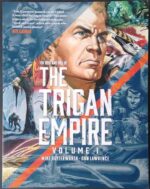 *Collected Editions: Brand new, Volume 1 of the collected Trigan Empire from Rebellion. The classic strip from Ranger & Look & Learn, written by Mike Butterworth and gloriously painted in full colour by the sublime Don Lawrence. A science-fiction mythos of a mighty empire, war against aggressive kingdoms, alien invaders and featuring incredible technologies. A generation grew up on this wonderful adventure and Rebellion’s new collection is the first affordable version of this masterpiece for decades.
*Collected Editions: Brand new, Volume 1 of the collected Trigan Empire from Rebellion. The classic strip from Ranger & Look & Learn, written by Mike Butterworth and gloriously painted in full colour by the sublime Don Lawrence. A science-fiction mythos of a mighty empire, war against aggressive kingdoms, alien invaders and featuring incredible technologies. A generation grew up on this wonderful adventure and Rebellion’s new collection is the first affordable version of this masterpiece for decades.
PICTURED: THE TRIGAN EMPIRE VOL 1 SC NEW/MINT £20
British Update: Big Cats Free Gift Farrago: Lion 1952 and Tiger 1967

 *Boys’ Adventure & War Comics: A duet of Big Cat Free Gift adventure this week! From 1952, the first year of publication, we have Lion #32 27/9/52 (VG) with its original Free Gift (VG), album of Scientific Wonders (flat but with rusty staple). Tiger from 21/10/67 is VG (nice but with a stacking ink defect to front cover), and original Free Gift in VF (unused sheet of Football Club Badges).
*Boys’ Adventure & War Comics: A duet of Big Cat Free Gift adventure this week! From 1952, the first year of publication, we have Lion #32 27/9/52 (VG) with its original Free Gift (VG), album of Scientific Wonders (flat but with rusty staple). Tiger from 21/10/67 is VG (nice but with a stacking ink defect to front cover), and original Free Gift in VF (unused sheet of Football Club Badges).
PICTURED:
LION 27/9/52 VG WITH FREE GIFT VG £30 SOLD
TIGER 21/10/67 VG WITH FREE GIFT VF £30 SOLD
British Update: Long Hot Summer: Rare TV Comic Holiday Specials, early 1970s
*TV & Film Related Comics: TV Comic is a highly collectible series featuring TV favourites, including in particular Dr Who and the Avengers. Not the most frequently appearing series, the Holiday Specials are even less so and turn up quite rarely. So we’re pleased to feature half a dozen examples in this update, from 1970-1976 (excluding 1975), mostly in nice grade. Dr Who and the Avengers appear in 1970, the Avengers in 1972, Dr Who in 1974 and 1976.
PICTURED: TV COMIC HOLIDAY SPECIAL
1970 VG £40 Dr Who, Avengers; moisture rippling SOLD
1971 VF £40 SOLD
1972 FN £35 Avengers SOLD
1974 FN £30 Dr Who SOLD
1976 VG/FN £27.50 Dr Who SOLD





British Update: Free Gift Farrago: Cracker #2 & #3

 *Humour Comics: A brace of Cracker here from 1975, #2 and #3, both with their original Free Gifts. #2 (VG/FN) has the Cracker Bang (unused VF); these paper noisemakers are a staple of British Comics, having been around since at least the 1930s, but because of the force necessary to get them to make the noise, they didn’t endure and seldom survive. #3 (FN) has the less fun but immaculate Free Gift (VF), 2 in 1 Facts ‘n’ Fun Book.
*Humour Comics: A brace of Cracker here from 1975, #2 and #3, both with their original Free Gifts. #2 (VG/FN) has the Cracker Bang (unused VF); these paper noisemakers are a staple of British Comics, having been around since at least the 1930s, but because of the force necessary to get them to make the noise, they didn’t endure and seldom survive. #3 (FN) has the less fun but immaculate Free Gift (VF), 2 in 1 Facts ‘n’ Fun Book.
PICTURED: CRACKER
#2 VG/FN WITH FREE GIFT VF £45
#3 FN WITH FREE GIFT VF £35
Clearance Corner: Rupert Adventure Series x 4 for just £25 with free postage

 *Clearance Corner: This is our ‘bargain basement’ section where we clear stock of titles we’re no longer carrying to make space. This week, we have fours issues in the Rupert Adventure series, which ran for 50 issues from 1948-1963. The later issues, which these all are, are all harder to find, presumably due to lower print runs. All were pictorial cardwrap booklets, mostly featuring two Rupert stories with differing puzzles. On offer here: #30, #35, #41 (illustrated) & #43, all in nice condition ranging from VG/FN – FN/VF. These normally sell for £20-£40 each. Yours for just £25 for all four, with free UK (only) postage.
*Clearance Corner: This is our ‘bargain basement’ section where we clear stock of titles we’re no longer carrying to make space. This week, we have fours issues in the Rupert Adventure series, which ran for 50 issues from 1948-1963. The later issues, which these all are, are all harder to find, presumably due to lower print runs. All were pictorial cardwrap booklets, mostly featuring two Rupert stories with differing puzzles. On offer here: #30, #35, #41 (illustrated) & #43, all in nice condition ranging from VG/FN – FN/VF. These normally sell for £20-£40 each. Yours for just £25 for all four, with free UK (only) postage.
Obituary: Denny O’Neil 1939-2020
 The legendary Batman and Green Lantern/Green Arrow writer has died of natural causes on the night of June 11th 2020 at his home.
The legendary Batman and Green Lantern/Green Arrow writer has died of natural causes on the night of June 11th 2020 at his home.
Dennis J. ‘Denny’ O’Neil’s career in comics spanned five decades, but he will be best remembered for his work on Batman and Green Lantern/Green Arrow, two long-running DC properties which he revitalized in the 1970s.
Commencing his career at Marvel Comics in the 1960s, he began on the non-hero titles, scripting for Millie the Model and Rawhide Kid among others; he progressed to X-Men, then, when work dried up at Marvel, moved first to Charlton – under the pseudonym of ‘Sergius O’Shaugnessy’, where he wrote the Fantastic Four derivative series ‘The Sentinels’ in Thunderbolt – and then to DC.
Together with editor Julius Schwartz and artist Neal Adams, O’Neil is regarded as instrumental in restoring the Batman to his noir origins, following a creative doldrum in the wake of the 1960s Batman television series. O’Neil created or co-created Ra’s Al Ghul, Talia, the League of Assassins, John Stewart, Leslie Thompkins and Azrael, among myriad other enduring characters; he also reinvented the Joker and Two-Face as major Batman adversaries.
In conjunction again with Neal Adams, O’Neil took on the faltering Green Lantern title in 1970, with issue #76, teaming the science-fiction hero with the newly-impoverished Ace Archer and sending them on a ‘journey across America’, introducing themes such as pollution, racism, overpopulation, drug addiction and other pressing social issues. Although never a huge commercial success, being cancelled with #89, Green Lantern/Green Arrow drew massive critical attention, multiple awards, and a great deal of controversy for its confrontational stance. O’Neil’s best-selling work from this period, however, was probably the Superman Vs. Muhammad Ali tabloid one-shot, again illustrated by Adams.
He returned to Marvel as both writer and editor, and in the latter capacity hired then-neophyte Frank Miller to take over the Daredevil title. He also wrote for television, including Batman: The Animated Series, GI Joe, Superboy and Logan’s Run.
In 2019, he was honoured by the city of Phoenix, Arizona, which designated May 25th that year ‘Dennis O’Neil Day’, to acknowledge his impact on the comics industry and in wider media.
Shop Update: We remain closed to visitors
Unfortunately, despite the Government’s announcement that non-essential shops can open on 15th June, we shall be remaining closed to visitors. Social distancing would be very difficult to maintain in our shop, and as we are designed for browsing, it would be impossible to prevent large quantities of our stock being touched, which would mean we’d be unable to trade safely. So we shall remain Covid-free and continuing our mail order service. We’re delighted to see so many people placing orders and are currently working hard to keep up with demand!
American Update: Batmania/DC Debuts: 1st Ra’s al Ghul in Batman #232
 *DC: Back to our Batman event this week with one of the most eagerly sought of all the Caped Crusader’s adventures. In Batman #232, creators Denny O’Neil and Neal Adams brought us one of Batman’s most significant villains: Ra’s al Ghul, a.k.a. the Head of the Demon, leader of the League of Assassins and father of Talia, the only woman who ever posed Catwoman a serious threat for the Caped Crusader’s affections. Both Talia and the League had made a couple of appearances before this, but this was the first time the readers saw the mysterious head of the League, and this issue kick-started an epic saga that continues to unravel to this very day, as well as opening the way for Ra’s appearances in the DC TV Universe and other media crossovers. This landmark issue, with gorgeous Neal Adams artwork throughout, is a solid VG, pence stamped, unmarked except for a little spine wear and a vertical crease a few mm in from the spine; staples are tight and firm.
*DC: Back to our Batman event this week with one of the most eagerly sought of all the Caped Crusader’s adventures. In Batman #232, creators Denny O’Neil and Neal Adams brought us one of Batman’s most significant villains: Ra’s al Ghul, a.k.a. the Head of the Demon, leader of the League of Assassins and father of Talia, the only woman who ever posed Catwoman a serious threat for the Caped Crusader’s affections. Both Talia and the League had made a couple of appearances before this, but this was the first time the readers saw the mysterious head of the League, and this issue kick-started an epic saga that continues to unravel to this very day, as well as opening the way for Ra’s appearances in the DC TV Universe and other media crossovers. This landmark issue, with gorgeous Neal Adams artwork throughout, is a solid VG, pence stamped, unmarked except for a little spine wear and a vertical crease a few mm in from the spine; staples are tight and firm.
PICTURED: BATMAN #232 VG p £140
American Update: DC Debuts: 1st Black Manta in Aquaman #35
 *DC: Black Manta is a ruthless undersea mercenary and has become established as the archenemy of Aquaman. He featured in the Aquaman movie and in his debut in Aquaman #35 in 1967, he vied with Aquaman’s other main foe, his half-brother Ocean Master, to destroy the Sea King. Our new copy of Aquaman #35 is VG-, pence stamped, a little tired with edge wear at all edges, a little more pronounced along the top, but otherwise okay.
*DC: Black Manta is a ruthless undersea mercenary and has become established as the archenemy of Aquaman. He featured in the Aquaman movie and in his debut in Aquaman #35 in 1967, he vied with Aquaman’s other main foe, his half-brother Ocean Master, to destroy the Sea King. Our new copy of Aquaman #35 is VG-, pence stamped, a little tired with edge wear at all edges, a little more pronounced along the top, but otherwise okay.
PICTURED: AQUAMAN #35 VG- p £95 SOLD
American Update: Spider-Mania Max/Mighty Marvel Firsts: 1st Mysterio in Amazing Spider-Man #13
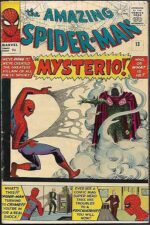 *Marvel: Regular visitors will know that we were in the middle of a special huge Spider-Man event before lockdown, and we’re delighted to be able to continue now with the appropriately numbered Amazing Spider-Man #13. We present the first appearance of another major member of Spidey’s Rogues’ Gallery. Peter Parker’s costumed alter ego faced one of his most baffling foes: Mysterio, whose inexplicable feats bordered more on the supernatural than the super-powered, and brought Spidey close to the edge of insanity. Steve Ditko’s artwork here transplanted a touch of his imagination from Doctor Strange to Spidey’s more urban environment, and from the visual evidence, Sturdy Steve was having great fun making both worlds collide! This is a very nice clean pence copy with just minor spine wear, unmarked, tight and flat with secure staples and off-white to cream pages; just a faint hint of tanning to the inside covers. Just the sort of copy I’d like in my collection!
*Marvel: Regular visitors will know that we were in the middle of a special huge Spider-Man event before lockdown, and we’re delighted to be able to continue now with the appropriately numbered Amazing Spider-Man #13. We present the first appearance of another major member of Spidey’s Rogues’ Gallery. Peter Parker’s costumed alter ego faced one of his most baffling foes: Mysterio, whose inexplicable feats bordered more on the supernatural than the super-powered, and brought Spidey close to the edge of insanity. Steve Ditko’s artwork here transplanted a touch of his imagination from Doctor Strange to Spidey’s more urban environment, and from the visual evidence, Sturdy Steve was having great fun making both worlds collide! This is a very nice clean pence copy with just minor spine wear, unmarked, tight and flat with secure staples and off-white to cream pages; just a faint hint of tanning to the inside covers. Just the sort of copy I’d like in my collection!
PICTURED: AMAZING SPIDER-MAN #13 VG+ p £475 SOLD
American Update: Mighty Marvel Firsts: Avengers #4, 1st Silver Age Captain America
 *Marvel: In the fourth issue of Marvel’s Avengers series, the already formidable team of Iron Man, Giant-Man, Thor and the Wasp was augmented by one of the legendary heroes from the past. Captain America returned to action after years in Post-WWII suspended animation, and rapidly became the acknowledged heart and soul of the Avengers, who have never flourished for long without him! This GD- pence copy has an unimpaired cover scene with good colour. The spine is worn, but intact; although there is a looseness at the staples, they are still reasonably well attached, particularly at the centrefold. Minor foxing inside covers, but a copy that presents pretty well for its grade.
*Marvel: In the fourth issue of Marvel’s Avengers series, the already formidable team of Iron Man, Giant-Man, Thor and the Wasp was augmented by one of the legendary heroes from the past. Captain America returned to action after years in Post-WWII suspended animation, and rapidly became the acknowledged heart and soul of the Avengers, who have never flourished for long without him! This GD- pence copy has an unimpaired cover scene with good colour. The spine is worn, but intact; although there is a looseness at the staples, they are still reasonably well attached, particularly at the centrefold. Minor foxing inside covers, but a copy that presents pretty well for its grade.
PICTURED: AVENGERS #4 GD- p £300
American Update: Spider-Mania Max/Mighty Marvel Firsts: Debut of Black Cat in Amazing #194
 *Marvel: Many folks say – with justification – that Felicia Hardy, the Black Cat, was a Suspiciously Similar Substitute for DC’s Catwoman, created to give Spider-Man a ‘beloved enemy’ vibe and increase the romantic tension in the series. Probably true; but nevertheless, the Black Cat rapidly stepped away from her derivative roots, primarily owing to her low level probability manipulation – subconsciously causing ‘bad luck’ for people who opposed her – and the fact that although she’s frequently done heroic and noble things, she’s never completely shed her criminal ways. This copy of the Black Cat’s debut in Amazing Spider-Man #194 comes from the non-distributed ‘wilderness years’, so there are no pence variants of this issue. A lovely VF/NM copy, with just a few minor pressure marks at the spine, not breaking colour.
*Marvel: Many folks say – with justification – that Felicia Hardy, the Black Cat, was a Suspiciously Similar Substitute for DC’s Catwoman, created to give Spider-Man a ‘beloved enemy’ vibe and increase the romantic tension in the series. Probably true; but nevertheless, the Black Cat rapidly stepped away from her derivative roots, primarily owing to her low level probability manipulation – subconsciously causing ‘bad luck’ for people who opposed her – and the fact that although she’s frequently done heroic and noble things, she’s never completely shed her criminal ways. This copy of the Black Cat’s debut in Amazing Spider-Man #194 comes from the non-distributed ‘wilderness years’, so there are no pence variants of this issue. A lovely VF/NM copy, with just a few minor pressure marks at the spine, not breaking colour.
PICTURED: AMAZING SPIDER-MAN #194 VF/NM £200 RESERVED
American Update: Slab Happy/Mighty Marvel Firsts: NYX #3: 1st X-23/Laura
 *Marvel: Regular readers will know that our Slab Happy event features third-party graded comics encased in plastic slabs by one of the American companies that do such things. This week’s example is NYX #3. A breakout hit of the early 21st Century, issue #3 of the short-lived series of NYX – short for ‘New York X-Men’ if you’re wondering – featured the first appearance of Wolverine’s ‘cloned daughter’ (it’s comic books, don’t worry about it), a brainwashed psychotic assassin who moonlighted as an underage hooker. And they say the age of heroes is dead. Be that as it may, the character’s popularity mushroomed as she was featured in Avengers Academy, Avengers Arena and New X-Men, and she briefly assumed the title of Wolverine herself during one of her putative cloned dad’s temporary demises. Interest was piqued further by a version of the character making her cinematic debut in the ‘Logan’ movie, causing this low-print run modern comic to acquire what seems to a casual eye a disproportionate ‘heat’. Our slabbed example is 9.6 (NM+).
*Marvel: Regular readers will know that our Slab Happy event features third-party graded comics encased in plastic slabs by one of the American companies that do such things. This week’s example is NYX #3. A breakout hit of the early 21st Century, issue #3 of the short-lived series of NYX – short for ‘New York X-Men’ if you’re wondering – featured the first appearance of Wolverine’s ‘cloned daughter’ (it’s comic books, don’t worry about it), a brainwashed psychotic assassin who moonlighted as an underage hooker. And they say the age of heroes is dead. Be that as it may, the character’s popularity mushroomed as she was featured in Avengers Academy, Avengers Arena and New X-Men, and she briefly assumed the title of Wolverine herself during one of her putative cloned dad’s temporary demises. Interest was piqued further by a version of the character making her cinematic debut in the ‘Logan’ movie, causing this low-print run modern comic to acquire what seems to a casual eye a disproportionate ‘heat’. Our slabbed example is 9.6 (NM+).
PICTURED: NYX #3 CGC 9.6 £380
American Update: Six Of The Best: Marvel Bronze Age #1 issues

 *Marvel: A scintillating sextet of Bronze Age #1 goodies, featuring Kirby’s Eternals, Godzilla (King Of The Monsters), the Invaders, Marvel Chillers (with Modred the Mystic), Marvel Feature 1975 (with Red Sonja) and Marvel Presents (with the first appearance of Bloodstone). Full details in our catalogue.
*Marvel: A scintillating sextet of Bronze Age #1 goodies, featuring Kirby’s Eternals, Godzilla (King Of The Monsters), the Invaders, Marvel Chillers (with Modred the Mystic), Marvel Feature 1975 (with Red Sonja) and Marvel Presents (with the first appearance of Bloodstone). Full details in our catalogue.
PICTURED:
ETERNALS #1 VG p £30 SOLD
INVADERS #1 VF £40 SOLD
American Update: What a Little Moon Knight Can Do…
 *Marvel: Moon Knight is a rising star of the Marvel Universe in the 21st Century, so we’re delighted to welcome a chunky run of most of his first ongoing series from 1980 new into stock. The multiple secret identity super-hero often considered an ersatz Batman has been around now since 1975, With Adamsesque art by the moody Bill Sienkiewicz on most issues and some stunning covers, this has very much become a fan favourite series in recent years, and a TV series has recently been announced. Issue #1 is pictured; see our catalogue for details of all issues new in.
*Marvel: Moon Knight is a rising star of the Marvel Universe in the 21st Century, so we’re delighted to welcome a chunky run of most of his first ongoing series from 1980 new into stock. The multiple secret identity super-hero often considered an ersatz Batman has been around now since 1975, With Adamsesque art by the moody Bill Sienkiewicz on most issues and some stunning covers, this has very much become a fan favourite series in recent years, and a TV series has recently been announced. Issue #1 is pictured; see our catalogue for details of all issues new in.
PICTURED: MOON KNIGHT #1 FN- p £20
American Update: Spider-Mania Max: Amazing Spidey Epic Collection
 *Modern Reprints: New this week, a new printing of the most requested Marvel Epic Collection of all: Amazing Spider-Man Vol 1, chock full of Lee & Ditko classics comprising the Spidey debut from Amazing Fantasy #15, Amazing Spider-Man #1-17 and Amazing Spider-Man Annual #1. As you can imagine, it’s a thick volume. And as if that’s not enough, there’s loads of extras, including all the covers (plus unused covers for AF #15 & ASM #10), the entre Ditko original art for AF #15 in photostat form, a photo gallery of the Marvel bullpen and lots more!
*Modern Reprints: New this week, a new printing of the most requested Marvel Epic Collection of all: Amazing Spider-Man Vol 1, chock full of Lee & Ditko classics comprising the Spidey debut from Amazing Fantasy #15, Amazing Spider-Man #1-17 and Amazing Spider-Man Annual #1. As you can imagine, it’s a thick volume. And as if that’s not enough, there’s loads of extras, including all the covers (plus unused covers for AF #15 & ASM #10), the entre Ditko original art for AF #15 in photostat form, a photo gallery of the Marvel bullpen and lots more!
PICTURED: AMAZING SPIDER-MAN EPIC COLLECTION £32
American/British Update: Korak, Son Of Tarzan
 *Tarzan/E R Burroughs: An international update for less commonly seen issues of Korak, Son of Tarzan. Starting with the American Gold Key series, we have 11 issues including #1 in a variety of grades. Also, 9 issues from the British Top Sellers series from #2 upwards, all in okay to fairly nice shape.
*Tarzan/E R Burroughs: An international update for less commonly seen issues of Korak, Son of Tarzan. Starting with the American Gold Key series, we have 11 issues including #1 in a variety of grades. Also, 9 issues from the British Top Sellers series from #2 upwards, all in okay to fairly nice shape.
PICTURED: KORAK #1 (GOLD KEY) GD- £7
British Update: Action 2020 – Hookjaw and friends are back!
 *Collected Editions: Hot off the presses is this brand new Summer Special from Rebellion: Action 2020, ‘the comic they tried to ban’. Featuring new stories of fan favourites Hookjaw (cuddly man-eating shark), Dredger, Hellman and others by the cream of British creators, it’s gtreat to see this title back on the stands!
*Collected Editions: Hot off the presses is this brand new Summer Special from Rebellion: Action 2020, ‘the comic they tried to ban’. Featuring new stories of fan favourites Hookjaw (cuddly man-eating shark), Dredger, Hellman and others by the cream of British creators, it’s gtreat to see this title back on the stands!
PICTURED: ACTION 2020 SPECIAL M £5
British Update: Free Gift Farrago: Hotspur 1967/68
*Boys’ Adventure & War Comics: Three vintage Hotspur issues this week from 1967/68, all complete with their original Free Gifts. From 1967, #412 complete with Free Gift ‘The Hotspur Glider’; the comic is nice with some tanning at edges, the gift is still in its sealed and unopened envelope. From 1968, #468 complete with Free Gift ‘The Hotspur Skimmer’; the comic is nice with minor foxing, the gift is still in its sealed and unopened envelope. Also from 1968, #469 complete with Free Gift ‘The Tootle Flute’; the comic has minor grubbiness, the gift is still mounted on its original card.
PICTURED: HOTSPUR:
#412 VG WITH FREE GIFT VF £35 SOLD
#468 VG WITH FREE GIFT VF £35 SOLD
#469 VG WITH FREE GIFT VF £35 SOLD



British Update: Free Gift Farrago: Bunty 1966/67

 *Girls’ Comics: Two classic issues of Bunty this week. From 1966, #459 complete with Free Gift ‘2 Lucky Charms’; the comic is a little creased and browned at the edges, the gift still in its sealed and unopened envelope. From 1967, #505 complete with Free Gift ‘the Fit-Any-Finger Ring’; the comic is a little creased and browned at right edge, the gift also still in its sealed and unopened envelope.
*Girls’ Comics: Two classic issues of Bunty this week. From 1966, #459 complete with Free Gift ‘2 Lucky Charms’; the comic is a little creased and browned at the edges, the gift still in its sealed and unopened envelope. From 1967, #505 complete with Free Gift ‘the Fit-Any-Finger Ring’; the comic is a little creased and browned at right edge, the gift also still in its sealed and unopened envelope.
PICTURED:
BUNTY #459 GD WITH FREE GIFT VF £35 SOLD
BUNTY #505 GD WITH FREE GIFT VF £35 SOLD
British Update: Summer Love with Girls’ Romance Picture Libraries
*Girls’ Picture Libraries: A selection of a few issues each of 1960s romance themed picture libraries fresh in, including the following titles: Confessions, Honeymoon Library, Hospital Nurse Picture Library, Red Rose Romances, Romantic Adventure Library, True Life Library & Young Lovers Picture Story Library (inc #1). Nearly all are in remarkable condition for their vintage, with many VF or FN, just a few brought lower by the all too common threat of rusty staples. From a variety of publishers, many of these feature beautiful and accomplished art.
PICTURED:
HOSPITAL NURSE LIBRARY #7 VF £10
RED ROSE ROMANCES #17 VF £15
YOUNG LOVERS PICTURE STORY LIBRARY #1 FN £20



Window Update: 30th Century Mail Order
To commemorate our current ‘mail order only’ status, our designer, Dr. Evilla, has created a display of notices which advise how you can contact us and shop with us online, plus listings of all the various categories of comics and books that we deal in, as displayed in the index to our catalogue online. Here are some pictures:





Week 10 – the Final Lockdown: Mail order trading from 1st June
As a result of the coronavirus pandemic, 30th Century Comics is changing the way we operate. All three of us who own and run the business are vulnerable either in terms of age, underlying health conditions or both. In planning the way forward for our business, we have to prioritise the health of ourselves and our customers.
We will, from Monday 1st June until further notice, be running a mail order service only; the shop will not be open to visitors. You will be able to contact us by email or letter to place orders or make enquiries. We’ve done a full risk assessment for our premises, and have determined that this is the only way we can safely operate under the current circumstances. In a shop designed for browsers, it would be impossible to prevent visitors touching the stock.
Our weekly newsletters will in future be issued on Saturdays, with replies to orders sent on Sundays. The first newsletter with new stock updates will be sent next Saturday 6th June and weekly thereafter.
Initially, we will be posting out orders midweek once a week; we may increase this frequency at a later date.
We will of course continue to monitor the global situation with regard to the pandemic and review our arrangements as things change. It may be possible at some later stage to arrange visitors by appointment, for example.
There are some advantages to these new arrangements for collectors and comic fans. We will have more time to list incoming stock, offering the widest possible range of material. Also, we will be working towards having our online catalogue totally up to date at all times, with sold items being deleted at point of sale, removing the frustration of seeing something you want that has already sold.
For a lot of our customers who are exclusively mail order already, there is no significant change. And for those of you who haven’t used our mail order service, you’ll find it easy to use, with orders securely packaged and sent fully insured. Obviously, we’d encourage you to give it a try; we’ve already been running our mail order service worldwide for decades, and highly successfully. You should note that we offer a full money back guarantee, including return postage, on any item that proves unsatisfactory.
We hope you’re keeping well in these difficult times and can continue your comic collecting hobby. ‘See’ you next Saturday with new stock updates.
Lockdown Interlude Week 9
We’ll have more news on our future trading operations and new stock newsletters next week. In the meantime, Will has been busy writing his latest article on the Secret Six, and has also added an obituary for Martin Pasko who wrote the latter series of that title and who sadly died earlier this month.
Secrets Of The Secret Six: DC’s ‘Mission: Impossible’
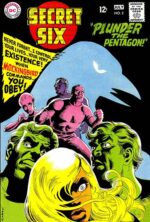 (with grateful acknowledgment to Keith W. Williams, whose similarly-titled article in the 1970’s informed much of my thinking on the topic.)
(with grateful acknowledgment to Keith W. Williams, whose similarly-titled article in the 1970’s informed much of my thinking on the topic.)
The TV show, Mission: Impossible, debuted in 1966, each episode opening with the team’s field leader selecting a task force from multiple dossiers to combat the Menace of the Week. In theory, this could have resulted in a cast of dozens; in reality, contractual obligations ‘selected’ the same series regulars plus maybe one guest-star, but nevertheless the series was a huge hit, running to 1973 for more than 150 episodes.
What’s this got to do with comics? Well, in 1968, DC was changing. Responding to the challenge posed by the rise of Marvel Comics, they were trying for new audiences, and a lot of experimental titles were being launched.
One such was Secret Six, a 1968 launch featuring a team of specialists recruited to perform covert missions, taking down targets beyond the reach of the law.
Writer E. Nelson Bridwell had clearly been briefed to rip-off Mission: Impossible as closely as possible, but, similarly to his earlier work on the Inferior Five, he took that remit and tweaked it into something quite distinctive.
In this case, the six protagonists were, as per M:I, specialists with distinctive skill sets, but each also, possessed a secret weakness in their past which, if disclosed or exploited would cause imprisonment, disgrace, or death. The ‘secret’ in the series’ title referred therefore not only to the furtive nature of their missions, but to the shadowed pasts of our various heroes.
And the biggest secret of all was that the group’s mysterious handler, code-named Mockingbird, his or her appearance and voice disguised in their pre-recorded briefings, was one of the team;
King Savage, stuntman and Korean War veteran, broke under torture and betrayed his country; Mockingbird arranged his escape so that he became a decorated hero – but the truth would reveal him as a traitor.
Carlo Di Rienzi, escapologist and magician, whose wife was killed and his son crippled in a revenge attack by organized crime; with Mockingbird’s treatments, the boy will walk again – as long as Carlo plays ball.
Lili Du Neuve, actress and disguise expert, falsely accused of murder and headed for the guillotine, until an equally mendacious alibi got her acquitted. But the alibi can be recanted at any time.
Tiger Force, former heavyweight champion on the run from the Mob after refusing to throw a fight, given a new name and life by Mockingbird;
Dr. August Durant, noted physicist, infected by enemy agents with a lethal virus for which only Mockingbird has the cure – one pill, day by day, to ensure ‘Doc’s’ compliance.
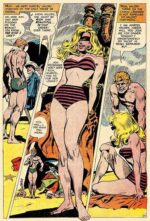 And Crimson Dawn, model, whose unusual upbringing gave her prowess in martial arts and marksmanship, but whose naiveté led her into an abusive marriage. Mockingbird reinvented her into a glamorous icon – whose sordid past could be revealed at any time.
And Crimson Dawn, model, whose unusual upbringing gave her prowess in martial arts and marksmanship, but whose naiveté led her into an abusive marriage. Mockingbird reinvented her into a glamorous icon – whose sordid past could be revealed at any time.
Each issue Mockingbird assigned the team to incriminate, incarcerate, or sometimes dispose of, enemies of the free world, international operations (unusually for the time, fully half our heroes were non-American) with meticulously-constructed plots, relying on no contrivances or ‘cheats’, and grounded firmly in the bounds of reality; no superhumans or supernatural elements in the Six’s world.
This verisimilitude was aided by artists Frank Springer (# 1-2) and Jack Sparling (#3-7), whose naturalistic style added conviction to the series. In the case of Sparling in particular – a notoriously inconsistent artist, whose on-page presentation varied widely from one assignment to another – his work on the Six was some of his best.
I mentioned earlier that credibility was a keynote of the series, but there was one overriding narrative coincidence; after the first couple of establishing issues, fate conspired to link the Six’s cases with events in their own histories. Over the course of the series, Lili revealed the true perpetrator of the crime she had been accused of, Carlo avenged the murder of his wife, and Crimson took healthy revenge upon her former husband, among other events. Had the series continued a few more issues, Mockingbird’s hold on the various members might have become so diluted as to be meaningless – although doubtless ENB would have come up with more reasons why the Six continued to operate.
 As it happened, though, he was denied the opportunity. Secret Six was cancelled with #7, one year after launch, and the group seemed destined to become a footnote in comic history, with the identity of Mockingbird still unrevealed.
As it happened, though, he was denied the opportunity. Secret Six was cancelled with #7, one year after launch, and the group seemed destined to become a footnote in comic history, with the identity of Mockingbird still unrevealed.
Until 1988 and DC’s ill-advised and short lived attempt to relaunch Action Comics as a weekly anthology title, with a number of short serialized strips. Most of these were pretty dismal, but one stood out as a quality successor. In Action Comics Weekly #601, writer Martin Pasko brought us a new Secret Six series.
Unlike most comics characters, who live in an eternal ageless ‘now’, the Six had aged in real time. Twenty years after their last recorded adventure, the youngest was now in her forties, and the elder teammates pensioners, broken down by age and infirmity. After two decades of inactivity, they were summoned once more by Mockingbird to train their successors – but en route, their plane crashes, with fatal results.
The new Secret Six, therefore, have to go into the field untrained. Mitch Hoberman, special effects tech crippled by arthritis; Ladonna Jameal, actress disfigured and rendered mute by an acid attack; Tony Mantegna, journalist deafened in an explosion; Luke McKendrick, paraplegic former track star; Vic Sommers, ex-marine blinded by shrapnel; and Dr. Maria Verdugo, computer scientist with incurable epilepsy.
All have variations on the same motivation. Having become disabled, their natural abilities are restored by cybernetic devices, enabling them to resume their former lives – and to do Mockingbird’s bidding.
Because one of the original Six survives. And Mockingbird can remotely disable his (or her) ‘gifts’ at any time, if the Six fail to comply.
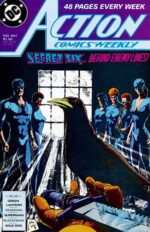 In two 12-chapter serials (Action Comics Weekly #601-612, and #619-630), Pasko did an exemplary job of evoking the original series and updating it, tying in missions to a larger story arc, and eventually resolving the question of who was Mockingbird, in a way that was entirely appropriate and satisfying to readers of the original.
In two 12-chapter serials (Action Comics Weekly #601-612, and #619-630), Pasko did an exemplary job of evoking the original series and updating it, tying in missions to a larger story arc, and eventually resolving the question of who was Mockingbird, in a way that was entirely appropriate and satisfying to readers of the original.
In this, he was aided by two veteran artists; the criminally underestimated Dan Spiegle illustrated the first serial, and in a pleasing nostalgic touch, the second was drawn by Frank Springer, the very first Secret Six artist. Each skillfully retained the authentic grounding of the series, with only one fantastic element – the cybernetic/bionic devices supplied by Mockingbird, borderline science-fiction in their sophistication – not detracting from the strip’s matter of fact tone.
The strip concluded with the possibility of a new Mockingbird, and a further sequel; but having been largely lost in the morass of inferior material ACW – often described as Action Comics Weakly because of its shoddy content – the strip caused no ‘ripples’, and, the title having been shoplifted for Gail Simone’s unrelated super-villain team-up title, the Secret Six remains unacknowledged by the DC Universe at large.
 Well, except for the far-better-than-it-ought-to-be Scooby-Doo Team-Up; in issue #30 (of the print version; #59 & #60 of the online version, don’t ask) the original line-up of the Secret Six made an appearance, together with Cave Carson’s crew, Rip Hunter’s team, the Challengers of the Unknown and the Sea Devils. It’s not canonical – but it is charming as hell, and, again, the secret of Mockingbird is disclosed!
Well, except for the far-better-than-it-ought-to-be Scooby-Doo Team-Up; in issue #30 (of the print version; #59 & #60 of the online version, don’t ask) the original line-up of the Secret Six made an appearance, together with Cave Carson’s crew, Rip Hunter’s team, the Challengers of the Unknown and the Sea Devils. It’s not canonical – but it is charming as hell, and, again, the secret of Mockingbird is disclosed!
Fear not; there will be no spoilers here. You want the identity of Mockingbird, you won’t get it from me. Google it. Or better yet, buy the comics – there aren’t that many to hunt down, and they well reward reading.
Will Morgan, May 2020
Martin ‘Pesky’ Pasko (1954-2020)
 Martin Pasko, comics and television writer, died on the 10th May 2020, of natural causes, at the age of 65.
Martin Pasko, comics and television writer, died on the 10th May 2020, of natural causes, at the age of 65.
Former DC publisher Paul Levitz, a friend of Pasko, announced his death through a Facebook post on 11th May;
“The odds are you’ve read his work, credited or not, or enjoyed a comic or cartoon or TV show or even a theme park event he made better, even as he relentlessly complained about the difficulties of making it as good as it ‘should’ be,” Levitz wrote. “Marty didn’t have a genius for making anything easy (especially for him), but he had a real genius for making creative magic.”
Born Jean-Claude Rochefort in Montreal, Quebec, Canada, Pasko first came to publisher’s attention as a frequent writer to DC’s lettercolumns in the 1960s, earning the nickname ‘Pesky’ Pasko because of his persistence in asking awkward questions.
His first professional assignment was a short story for Warren Publishing’s Creepy in 1973, but his first DC work was for Superman in 1974, beginning a thirty-year association with Superman Family related series, but he wrote a multitude of other DC strips, including Justice League of America, Wonder Woman, DC Comics Presents, Metal Men, Swamp Thing, the World’s Greatest Super-Heroes newspaper strip starring the Justice League and others, and the revivals of the Secret Six and Blackhawk in Action Comics. He also worked occasionally for Marvel, including a stint as regular scripter of their Star Trek adaptation.
He wrote extensively for television, on series such as Roseanne, Max Headroom, Buck Rogers, Fantasy Island, Teenage Mutant Ninja Turtles and Cheers, as well as a long association with the DC Animated Universe, winning a Daytime Emmy Award for Batman: The Animated Series.
Lockdown Interlude Week 8
This week’s visit to our collections and favourite titles comprises two very different series, four decades apart and of very different nature, highlighting the rich diversity of entertainment that the medium of comics can provide. Enjoy! Until next week, keep well and stay safe.
All American Girl: Marvel Comics’ First Super-Heroine
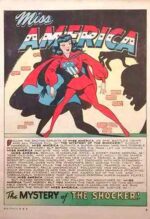 Madeleine Joyce, a.k.a. Miss America, holds a unique position in the Marvel Universe – she’s the first super-powered woman from that company (not then known as Marvel, of course) to don a distinctive costume and battle for the forces of good.
Madeleine Joyce, a.k.a. Miss America, holds a unique position in the Marvel Universe – she’s the first super-powered woman from that company (not then known as Marvel, of course) to don a distinctive costume and battle for the forces of good.
She had two predecessors, of sorts, but one wasn’t super, and the other definitely was no heroine, although she did unwittingly do good things. Zara, a generic, if reasonably modest jungle queen, debuted in Mystic Comics #2 (April 1940), and the decidedly more interesting Black Widow (no relation to Madame Natasha) premiered in Mystic #4 (August 1940), a Satanically resurrected medium who went around slaughtering evil men to consign their souls to Hell.
But it wasn’t until Marvel Mystery Comics #49 (November 1943) that a bona fide super-heroine emerged. Madeline Joyce was a 16-year old orphan living with her late father’s business partner (Child protection laws being hazier back then…) whom she addressed as ‘Uncle Jim’. Uncle Jim takes Maddie to visit a scientist friend – but en route, Madeline’s social warrior bona fides are established when she intervenes as a crippled newsboy is being bullied.
Uncle Jim’s chum, Professor Lawton, explains agitatedly that his invention has gifted him with superhuman strength, the ability to defy gravity, and ‘unusual perception’. Fearing that his old pal’s one issue short of a mini-series, Uncle Jim hastily escorts Madeleine away, but our do-gooding heroine returns late at night to snoop about, and zaps herself with Lawton’s invention. Lawton finds the unconscious girl, and, thinking her dead, remorsefully destroys himself and his machine– but on awakening, Madeleine is gifted with amazing powers, and decides to use them to defend the common man as Miss America!
 Originally those powers were flight, x-ray vision (which could not only penetrate objects, but destroy them), ‘the wisdom of the ages’, and ‘the strength of a thousand men!’, putting our heroine in the Superman class and making her Timely’s most powerful hero by quite a margin. Within a few issues the power set was toned down to flight and some level of physical superiority – enough that she could break ropes and sometimes chains, but could still be overwhelmed by, say, a sneaky blow to the back of the head.
Originally those powers were flight, x-ray vision (which could not only penetrate objects, but destroy them), ‘the wisdom of the ages’, and ‘the strength of a thousand men!’, putting our heroine in the Superman class and making her Timely’s most powerful hero by quite a margin. Within a few issues the power set was toned down to flight and some level of physical superiority – enough that she could break ropes and sometimes chains, but could still be overwhelmed by, say, a sneaky blow to the back of the head.
All of this is pretty standard for the time, but Miss America stood out through her independence. Of an age when she’d be expected to be a sidekick, she was out on her own. She’s often dismissed (even by some sloppy so-called ‘experts’) as a distaff Captain America, but there was no connection between them – they didn’t even meet until three years after her creation – and her power set was both different from and superior to Cap’s. In-story, although nominally the ‘ward’ of her father’s pal Jim, Madeline drove around town on her own, had (at least some of the time) a luxurious penthouse apartment, and lived a remarkably unsupervised life for a minor. And uniquely for a 1940s heroine, there was no boyfriend, no steady, no male authority figure of any kind, and never the remotest hint of romance. Unencumbered by a drippy love interest, she took charge and kicked arse on her own initiative –often with lethal consequences to her foes. Okay, she didn’t actually set out to kill any of them – but if they were collateral damage during battle, she was very much ‘Well, they brought it on themselves’.
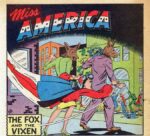 And what villains they were! Yes, the usual thugs, mobsters and con men – often with quite ingenious schemes – but also a variety of strange and disturbing malfeasants with horrific overtones. King Cobra, the Fox and the Vixen, the Black Widow (not that one – no, not that other one, either), the Flaming Hate, the Walking Corpse, Miss Bluebeard, the Ghoul of the 13th Floor, Adonis, the Shocker – all introduced and dispatched in short order, usually in seven pages or less, taut action thrillers that could teach a great many of today’s waddling, flatulent ‘storytellers’ some tricks about moving a plot along!
And what villains they were! Yes, the usual thugs, mobsters and con men – often with quite ingenious schemes – but also a variety of strange and disturbing malfeasants with horrific overtones. King Cobra, the Fox and the Vixen, the Black Widow (not that one – no, not that other one, either), the Flaming Hate, the Walking Corpse, Miss Bluebeard, the Ghoul of the 13th Floor, Adonis, the Shocker – all introduced and dispatched in short order, usually in seven pages or less, taut action thrillers that could teach a great many of today’s waddling, flatulent ‘storytellers’ some tricks about moving a plot along!
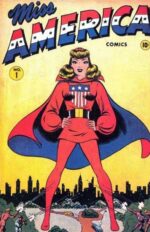
 Within a year Madeline got her own title, and by contemporary accounts Miss America Comics #1 was a huge success. Yet with the second issue, it morphed into Miss America Magazine, a curious amalgam of women’s mag and comic book, with most pages given over to text about fashion, movies and beauty tips. Further, issue #2, despite an unusual photocover of our costumed heroine, carried within it the debut of Patsy Walker, a teen comedy heroine who within a few issues would shoplift Madeleine’s own title away from her! Miss America Magazine continued until the late 1950s – but without Miss America in it!
Within a year Madeline got her own title, and by contemporary accounts Miss America Comics #1 was a huge success. Yet with the second issue, it morphed into Miss America Magazine, a curious amalgam of women’s mag and comic book, with most pages given over to text about fashion, movies and beauty tips. Further, issue #2, despite an unusual photocover of our costumed heroine, carried within it the debut of Patsy Walker, a teen comedy heroine who within a few issues would shoplift Madeleine’s own title away from her! Miss America Magazine continued until the late 1950s – but without Miss America in it!
Miss America solo stories continued to run in Marvel Mystery Comics until #85 (February 1948), as well as occasional guest gigs in other titles such as All-Select and Blonde Phantom. The final ten MMC stories were, unusually for the time, chapters of a tale intended to invoke movie serials, with Madeline recruited by government intelligence to track down a list of Nazi war criminals intercepted by enemy agents.
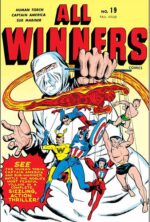 Her highest profile gig, however, was in All-Winners Comics #19 and #21, the only two appearances of the All-Winners Squad, Timely’s attempt at a super-hero team. Alongside Captain America and Bucky, the Human Torch and Toro, the Sub-Mariner and the Whizzer, Miss America faced off against Isbisa and the evil duo of Future Man and Madame Death, acquitting herself admirably.
Her highest profile gig, however, was in All-Winners Comics #19 and #21, the only two appearances of the All-Winners Squad, Timely’s attempt at a super-hero team. Alongside Captain America and Bucky, the Human Torch and Toro, the Sub-Mariner and the Whizzer, Miss America faced off against Isbisa and the evil duo of Future Man and Madame Death, acquitting herself admirably.
With dwindling Post-War interest in super-heroes, the publisher switched tack to other genres – war, crime, romance, horror, western – famously reinventing themselves in 1961 with the publication of Fantastic Four #1 and what would become the Marvel Universe. By 1975, fan-turned-pro Roy Thomas had revived the Cap, Torch and Namor in new WW-II stories as the Invaders, and he followed up with a second team, the Liberty Legion. Miss America was present, but while portrayed as a perfectly competent heroine, the zing and zip of her Golden Age adventures was lacking. Instead of a solo star, she was one of an ensemble, and Thomas having previously romantically linked her and fellow-Legionnaire the Whizzer in a retcon flashback in Giant-Size Avengers #1, her subplots were inevitably pivoted around her boyfriend’s.
 There was one more solo Miss A. adventure, though. In 2009, a Miss America Special was released, along with other ‘new’ Golden Age one-offs to celebrate the company’s 70th Anniversary, and Jen Van Meter and Andy MacDonald provided, in ‘Shipyard Sabotage’, a rollicking retro romp, complete with a United Nations of villainous spy gals!
There was one more solo Miss A. adventure, though. In 2009, a Miss America Special was released, along with other ‘new’ Golden Age one-offs to celebrate the company’s 70th Anniversary, and Jen Van Meter and Andy MacDonald provided, in ‘Shipyard Sabotage’, a rollicking retro romp, complete with a United Nations of villainous spy gals!
Miss America’s place in Marvel history has now been largely usurped by America Chavez, a bisexual Latina heroine from an alternate dimension who was introduced in 2011, and who has become popular through appearances in the Young Avengers and elsewhere. While America Chavez (also sometimes known as Miss America) is a fun character, inventive, ground-breaking and imaginative, it’s a pity that she’s occupied the ‘ecological niche’ of Madeline Joyce to the extent that, when Marvel Comics #1000 was published with a retrospective view of all significant events in Marvel’s history, the page specifically citing Marvel Mystery Comics #49 featured, not Madeline Joyce… but America Chavez.
It’s time to give the gal some respect, Marvel. She was the first costumed heroine of your history, a major player in the 1940s, and, through retcons and flashbacks, still a presence in the Marvel Universe despite the fact she’s been deceased since the 1950s! Give a girl her due.
No harm to America Chavez, but really – isn’t there room in fandom’s heart for two Misses America?
Will Morgan, May 2020
The Maze Agency: Detective Fiction In Comic Form (with Adam Hughes)
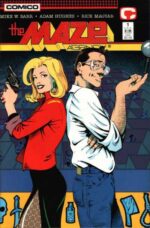 Something a little different this week, as we take a look at something more modern than our usual fare (if you count 1988 as modern, that is!). The Maze Agency was one of the series to benefit from the ‘Indie Boom’ of the 1980s, a rich vein of quality material from other than the big publishers and not focusing on super-heroes. It’s crime or detective fiction, of the Golden Age whodunit style of Christie, Doyle, Sayers etc rather than the hard-boiled stuff of Chandler and Spillane etc, but with a contemporary setting.
Something a little different this week, as we take a look at something more modern than our usual fare (if you count 1988 as modern, that is!). The Maze Agency was one of the series to benefit from the ‘Indie Boom’ of the 1980s, a rich vein of quality material from other than the big publishers and not focusing on super-heroes. It’s crime or detective fiction, of the Golden Age whodunit style of Christie, Doyle, Sayers etc rather than the hard-boiled stuff of Chandler and Spillane etc, but with a contemporary setting.
The Maze Agency is a New York detective outfit run by Jennifer Mays, ex-CIA, wealthy, successful and drop dead gorgeous. She’s joined on her cases by her chap Gabriel Webb, a true crime writer and amateur sleuth, who’s usually just as sloppily dressed as Jennifer is elegantly turned-out. Together they solve impossible crimes and unfathomable whodunits. Each story is a challenge to the reader to solve the clues leading to the revelation of the murderer or resolution of the mystery. I have to say that these are not easily solved!
 One of the highlights of the series (apart from the mysteries, of course) is the verbal interplay between Jennifer & Gabe, full of witty banter and sparking repartee. Imagine ‘Moonlighting’ with decent plots and adult characters. Having said that, Jennifer and Gabe are much more equals, like Maddy and David, rather than Holmes & Watson or Poirot & Hastings. There is also a cast of regular supporting characters, from the (even more slovenly than Gabe) Lt Roberta Bliss and her sidekick Sgt Stubbs, rival detective Ashley Swift, Jennifer’s parents and her secretary Sandy.
One of the highlights of the series (apart from the mysteries, of course) is the verbal interplay between Jennifer & Gabe, full of witty banter and sparking repartee. Imagine ‘Moonlighting’ with decent plots and adult characters. Having said that, Jennifer and Gabe are much more equals, like Maddy and David, rather than Holmes & Watson or Poirot & Hastings. There is also a cast of regular supporting characters, from the (even more slovenly than Gabe) Lt Roberta Bliss and her sidekick Sgt Stubbs, rival detective Ashley Swift, Jennifer’s parents and her secretary Sandy.
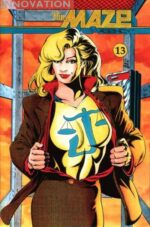 The Maze Agency has a confusing publication history. The original series of issues #1-7 were from Comico; then publication switched to Innovation after Comico folded for issues #8-23 of the original run, plus 1 Annual, 1 Special and a TPB which featured a new cover and story as well as reprinting issues #1-4. Then in 1993, there was a Maze Agency short in the anthology title The Detectives from Alpha Productions. Finally, there were two short series of 3 issues each from Caliber (1997) and IDW (2005). (There were a couple of prose stories in other titles, but I’ve never seen those).
The Maze Agency has a confusing publication history. The original series of issues #1-7 were from Comico; then publication switched to Innovation after Comico folded for issues #8-23 of the original run, plus 1 Annual, 1 Special and a TPB which featured a new cover and story as well as reprinting issues #1-4. Then in 1993, there was a Maze Agency short in the anthology title The Detectives from Alpha Productions. Finally, there were two short series of 3 issues each from Caliber (1997) and IDW (2005). (There were a couple of prose stories in other titles, but I’ve never seen those).
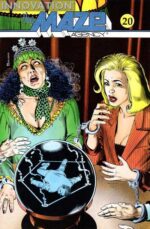 All the stories were written by the series creator Mike W Barr, a self-confessed fan of the genre. The original designs for Jennifer and Gabe were by Alan Davis (who drew the pilot story ‘The Mile-High Corpse’ which eventually surfaced in the Special, having been produced in 1986, two years before issue #1 and as a vehicle for Barr to promote the series to prospective publishers). By the time we got to 1988, the regular pencilling assignment had been allocated to a newcomer by the name of Adam Hughes.
All the stories were written by the series creator Mike W Barr, a self-confessed fan of the genre. The original designs for Jennifer and Gabe were by Alan Davis (who drew the pilot story ‘The Mile-High Corpse’ which eventually surfaced in the Special, having been produced in 1986, two years before issue #1 and as a vehicle for Barr to promote the series to prospective publishers). By the time we got to 1988, the regular pencilling assignment had been allocated to a newcomer by the name of Adam Hughes.
These days Hughes is one of the hottest names in comics; his work (mostly restricted to covers) is avidly collected, and his original art changes hands for small fortunes. Back in 1988 he was an unknown; I remember buying #1 (being a fan of the genre myself) and thinking ‘wow, this artist isn’t bad for an Alan Davis imitator…’ He drew #1-5, #8-9 plus #12 of the original series, plus the short in the TPB ‘Murder In Mint Condition’, originally presented as a promotional copy at the San Diego ComicCon 1988. Back then, kids, you got a whole comic drawn by Hughes! As well as this, he drew many subsequent covers, the last being on issue #3 of the Caliber series. There was a nice bonus in the Comico run in that the back cover featured a Hughes picture advertising the next issue (which wasn’t the cover of the next issue), so you got in effect an extra cover by him. When the series switched to Innovation, the covers changed to appealing wraparounds.
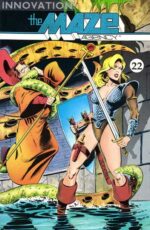 The artwork following Hughes was usually competent, sometimes excellent if seldom spectacular, although there was a fine range of cover artists including Alan Davis, Russ Heath and Brian Bolland. There’s a brief cover gallery included here (from top to bottom): Maze Agency #1 (Comico) by Hughes, #11 (Innovation) by Alan Davis, #13 by Hughes (Jennifer appears as the super-heroine Justice Girl at a fancy dress ball), #20 by Brian Bolland, #22 by J Trent and Jan Duursema (a fantasy sequence in a role-playing game mystery) and #3 (Caliber) by Hughes. A word should also be said in praise of Rick Magyar, whose fine inks adorned the work of Hughes and many other artists on the series.
The artwork following Hughes was usually competent, sometimes excellent if seldom spectacular, although there was a fine range of cover artists including Alan Davis, Russ Heath and Brian Bolland. There’s a brief cover gallery included here (from top to bottom): Maze Agency #1 (Comico) by Hughes, #11 (Innovation) by Alan Davis, #13 by Hughes (Jennifer appears as the super-heroine Justice Girl at a fancy dress ball), #20 by Brian Bolland, #22 by J Trent and Jan Duursema (a fantasy sequence in a role-playing game mystery) and #3 (Caliber) by Hughes. A word should also be said in praise of Rick Magyar, whose fine inks adorned the work of Hughes and many other artists on the series.
 The artwork is a bonus. As a fan of detective fiction myself (from Sherlock Holmes through to Phryne Fisher), I love these stories and the ‘fair play’ challenge of writer Barr to the reader. And I also love the relationship between Jennifer and Gabe, with a tip of the hat to their comic predecessors: Ralph & Sue, Carter & Shiera and Hank & Jan (and if you don’t know who I’m talking about, shame on you!). Can I dare to hope that one day we may yet see the further adventures of the Maze Agency?
The artwork is a bonus. As a fan of detective fiction myself (from Sherlock Holmes through to Phryne Fisher), I love these stories and the ‘fair play’ challenge of writer Barr to the reader. And I also love the relationship between Jennifer and Gabe, with a tip of the hat to their comic predecessors: Ralph & Sue, Carter & Shiera and Hank & Jan (and if you don’t know who I’m talking about, shame on you!). Can I dare to hope that one day we may yet see the further adventures of the Maze Agency?
Rob Rudderham, May 2020
Lockdown Interlude Week 7
We’re back again with some more musings on excerpts from our personal collections, which we hope will entertain and enlighten you. We’ve also been keeping busy during this lockdown period working on thousands of comics we brought to our respective homes, getting them ready to list on our website when we can finally trade again, so you can expect lots of wonderful stuff to be available in due course. And when there’s news on that, you’ll hear it right here. Keep well and stay safe!
Red Circle Sorcery: Archie’s Best-Kept Secret
 Following certain relaxations of the Comics Code Authority in the late 1960s, comics, led by DC, revisited the defunct horror genre. The precedent, of course, had been set by Warren publishing’s 1964 release of Creepy (to be followed up by Eerie), horror comics anthologies released as larger format black & white magazines, therefore exempt from the Comics Code’s aegis. Their success demonstrated that the audience was still present, and DC editor Joe Orlando, himself an alumnus of the classic EC horror line and a contributor to Creepy et al, seized the opportunity to revive the field in four-colour format.
Following certain relaxations of the Comics Code Authority in the late 1960s, comics, led by DC, revisited the defunct horror genre. The precedent, of course, had been set by Warren publishing’s 1964 release of Creepy (to be followed up by Eerie), horror comics anthologies released as larger format black & white magazines, therefore exempt from the Comics Code’s aegis. Their success demonstrated that the audience was still present, and DC editor Joe Orlando, himself an alumnus of the classic EC horror line and a contributor to Creepy et al, seized the opportunity to revive the field in four-colour format.
Titles such as House of Mystery and House of Secrets, previously devoted for more than a decade to tepid science-fiction or alien/monster/robot tales, returned to chilling form with contributors such as Toth, Wrightson, Adams, Wood and more recreating the suspenseful stories of yesteryear, without the frequently excessive gore and viscera which had caused them to be condemned in the first place. Shortly thereafter, the venerable Unexpected followed suit, to be joined by new titles The Witching Hour and Ghosts, forming the nexus of a horror/mystery line which endured for two decades.
Predictably, other publishers jumped on the bandwagon; Marvel’s Tower of Shadows and Chamber of Darkness were replete with high-quality work from top-notch creators, but the unstoppable demands of the Marvel Superhero Universe meant that within the year Marvel’s horror titles (of which there were many, lasting until the end of the 1970s) became reprints chosen for page length rather than quality.
The eternal also-ran Charlton, however, made a go of it, with multiple titles such as Many Ghosts of Doctor Graves and Ghost Manor running from the late 60s to the early 80s. Their crank-it-out schedule meant there was a terrible lot of trash, but frequent gems also, from Steve Ditko, Tom Sutton, Jim Aparo and early works by Mike Zeck and Don Newton.
In all this sudden flurry, one high quality line of horror/mystery comics crept out all but unnoticed. I, personally, didn’t encounter them until almost a year after they were all over, and having been active in comics fandom since 1972, I really was surprised they got past me.
Darlington, 1976; my first job, working in a book exchange, sorting through the second-hand American comics. In among the interminable Charlton adaptations of unseen TV series, I found a comic entitled Sorcery. Intrigued, I looked through, and saw pages of lovely artwork by Gray Morrow, one of my favourite artists, in a series previously completely unknown to me. These beautifully-drawn, skilfully-told tales of the supernatural easily rivalled the DC mystery line (which by that time was getting rote and repetitive, relying on lesser artists), and I couldn’t believe it had eluded me.
Thus began a quest to ‘catch them all’ – something I only finally achieved in the early days of the 21st century. Not that there are that many – 12, to be exact. But they’re not at all easy to find, and the history is kind of peculiar.
 Dated September and October, 1972, Archie Comics produced a peculiar title: Chilling Adventures In Sorcery, as Told By Sabrina. Yep, that Sabrina, the Teenage Witch. Sabrina was still going great guns in her own Bewitched-esque light comedy title, and had been the star of an animated TV show a few years earlier. But this two-shot title featured Sabrina narrating horror stories – some of them quite strong for Code-approved fare – which were illustrated by Stan Goldberg in the traditional cartoon Archie style, resulting in a cognitive dissonance which is quite unsettling to the viewer.
Dated September and October, 1972, Archie Comics produced a peculiar title: Chilling Adventures In Sorcery, as Told By Sabrina. Yep, that Sabrina, the Teenage Witch. Sabrina was still going great guns in her own Bewitched-esque light comedy title, and had been the star of an animated TV show a few years earlier. But this two-shot title featured Sabrina narrating horror stories – some of them quite strong for Code-approved fare – which were illustrated by Stan Goldberg in the traditional cartoon Archie style, resulting in a cognitive dissonance which is quite unsettling to the viewer.
These two issues sank pretty much without trace. The fact that they were released in consecutive months indicates that they were only ever intended as a ‘tryout’, not intended as ongoing. But a full year later, dated October 1973, saw the release of Chilling Adventures In Sorcery #3, cannily re-purposing an existing title to save copyright licensing fees.
This was a very different series. From the stunning cover, featuring a range of classic horror figures, it was clearly not for the kiddies. Illustrated throughout by Gray Morrow, who also edited the title and pitched the concept, the four stand-alone stories – plus a one-page ‘Essays Into the Supernatural’ feature – were skilful, evocative and haunting. Published under the Red Circle imprint, to differentiate it from the anodyne adventures of Archie et al, the nervous publishers guarded their public image, but committed to further issues.
 And what issues they were. The debut, #3, is the only issue to be drawn entirely by Morrow, but he provided all of the striking covers, plus frequent interior stories. His realistic style was the template – with a handful of exceptions – the naturalistic depiction grounding and adding verisimilitude to the supernatural events. The quality was maintained throughout, with contributors such as veterans Vincente Alcazar, Alex Toth, Doug Wildey, Carlos Pino and Pat Boyette, plus relative newcomers (at that time) Frank Thorne, Howard Chaykin and Bruce Jones.
And what issues they were. The debut, #3, is the only issue to be drawn entirely by Morrow, but he provided all of the striking covers, plus frequent interior stories. His realistic style was the template – with a handful of exceptions – the naturalistic depiction grounding and adding verisimilitude to the supernatural events. The quality was maintained throughout, with contributors such as veterans Vincente Alcazar, Alex Toth, Doug Wildey, Carlos Pino and Pat Boyette, plus relative newcomers (at that time) Frank Thorne, Howard Chaykin and Bruce Jones.
The sso ries suffered from poor distribution even in its native America (and was almost unseen in the UK at the time of release, even more than mainstream Archie’s patchy and highly regional distribution), but nevertheless appears to have been a modest success. Chilling Adventures In Sorcery (which re-tweaked its title into Red Circle Sorcery before finally settling on simply Sorcery) actually gained a companion title, briefly – and that’s another peculiar tale.
Since 1959, Archie’s Madhouse had featured lightweight satire and parody, featuring not only Archie’s Pals N’ Gals, but other recurring characters, such as dollar-store super-hero Captain Sprocket and, most famously, the aforementioned Sabrina, who made her debut in issue #22. It was amiable comedy, trundling innocuously along, a diet-Mad for the younger set.
 Until issue #95 (dated September 1974), when it flipped over into Madhouse, a horror title identical in style and content to Sorcery – which must have been quite a jolt to the parents of young subscribers, especially when #96, with a surprisingly risqué cover for 1974, plopped through the letterbox!
Until issue #95 (dated September 1974), when it flipped over into Madhouse, a horror title identical in style and content to Sorcery – which must have been quite a jolt to the parents of young subscribers, especially when #96, with a surprisingly risqué cover for 1974, plopped through the letterbox!
The ‘horror makeover’ for Madhouse lasted only three issues. With #97, January 1975, Madhouse was cancelled – the same release date as the final issue of Sorcery, #11. Madhouse was actually revived with #98 later in the year, but with the same cartoony parodies as before, the horror interlude determinedly disregarded.
The reasons behind the cancellations have never been quite clear. In the broader market, readers certainly hadn’t turned away from horror – DC’s and Charlton’s mystery lines both thrived into the 1980s. The quality of the titles was, at the time of their release, unmatched. And there must have been some ‘buzz’ around Sorcery to produce a companion title, however short-lived.
One can only speculate that there was a managerial change of heart, possibly in response to reader feedback – maybe the (albeit strategically) topless young lady on Madhouse #96’s cover drew too much ire from Middle America!
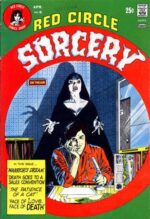
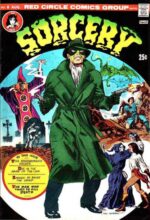 But for 12 issues – Sorcery #3-11, and Madhouse #95-97 – there was briefly a line that matched, if not outstripped, the finest that other publishers of horror/mystery comics were publishing, and it remains, paradoxically, almost unknown even to this day.
But for 12 issues – Sorcery #3-11, and Madhouse #95-97 – there was briefly a line that matched, if not outstripped, the finest that other publishers of horror/mystery comics were publishing, and it remains, paradoxically, almost unknown even to this day.
Will Morgan, May 2020
It’s A Jungle Out There: The Story of Lorna the Jungle Girl (sometimes Queen)
Although these days she may be regarded as something of a backwater of the Marvel Universe, Lorna the Jungle Girl was successful enough following her launch in 1953 to sustain a 26 issue series (something many of today’s titles would be proud of). Not that she was truly part of the Marvel Universe, of course; Marvel in those days was known as Atlas, and Lorna is perhaps one of the few characters in Marvel’s history (who had her own title) not to be reinvented in the Silver Age or since.
It was a crowded jungle by the time Lorna found her way into it. Tarzan had boomed on the silver screen long before comics had started up properly, and he wasn’t long in becoming the first of a long line of jungle kings and queens to take up residence in Africa (it’s a good job they didn’t have social distancing then). Sheena (the first female character to get her own series), Rulah, Zago, Zegra, Jo-Jo, White Princess of the Jungle, Kaanga, Judy of the Jungle, Princess Pantha, Camilla, Tiger Girl etc all preceded Lorna. Even within Atlas she had her rivals: Jann of the Jungle, Lo-Zar, Jungle Boy and Leopard Girl. And that’s even without counting other characters whose habitat was the jungle but were less the swinging through the trees dressed in animal skins types, such as the Phantom, Jungle Jim and Nyoka the Jungle Girl. It was a popular place.
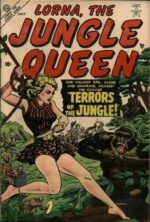 So, what makes Lorna special? Let’s take a look at her debut issue. (The first five issues were entitled Lorna the Jungle Queen before she was ‘dethroned’ (without explanation) for issues #6-26). Lorna was created by writer Don Rico, who wrote all her stories and artist Werner Roth, who drew all the Lorna stories up to #12, with Jay Scott Pike taking over from #13 to the end of the series. In the initial story, rather unimaginatively entitled ‘The Coming Of Lorna’, we are introduced to a white man and his grown daughter. The man is a hunter whose home has been the jungle for 35 years; unfortunately, on the very first page, he is savaged by a lion and sustains injuries from which he eventually dies. His daughter, Lorna, vows to become as great a hunter as her father had been, to compensate for the son he never had, and a friendly native, M’Tuba, volunteers to teach her the skills of spear and knife, assisted by Mikki the monkey. A page later (although in fairness many months have passed), Lorna is ready to adopt an outfit of animal skins (less revealing than many of her jungle ‘siblings’,), but before she can set about putting her skills to use, Lorna and M’Tuba are captured by the notorious Wafisi tribe and taken to their village. Before the apparent cannibalistic ritual, Lorna manages to escape and best the Wafisi witch doctor. She proclaims herself witch doctor, and appoints M’Tuba to rule in her place. The Wafisi tribe hail her as ‘the jungle queen’. Lorna then vows to ‘travel deeper into the jungle… as my father would have wanted me to… to seek out others who may need help!’ M’Tuba gifts her Mikki the monkey, and together girl and monkey ‘walk into the deep shadows of the African jungle… into the mysterious unknown!’
So, what makes Lorna special? Let’s take a look at her debut issue. (The first five issues were entitled Lorna the Jungle Queen before she was ‘dethroned’ (without explanation) for issues #6-26). Lorna was created by writer Don Rico, who wrote all her stories and artist Werner Roth, who drew all the Lorna stories up to #12, with Jay Scott Pike taking over from #13 to the end of the series. In the initial story, rather unimaginatively entitled ‘The Coming Of Lorna’, we are introduced to a white man and his grown daughter. The man is a hunter whose home has been the jungle for 35 years; unfortunately, on the very first page, he is savaged by a lion and sustains injuries from which he eventually dies. His daughter, Lorna, vows to become as great a hunter as her father had been, to compensate for the son he never had, and a friendly native, M’Tuba, volunteers to teach her the skills of spear and knife, assisted by Mikki the monkey. A page later (although in fairness many months have passed), Lorna is ready to adopt an outfit of animal skins (less revealing than many of her jungle ‘siblings’,), but before she can set about putting her skills to use, Lorna and M’Tuba are captured by the notorious Wafisi tribe and taken to their village. Before the apparent cannibalistic ritual, Lorna manages to escape and best the Wafisi witch doctor. She proclaims herself witch doctor, and appoints M’Tuba to rule in her place. The Wafisi tribe hail her as ‘the jungle queen’. Lorna then vows to ‘travel deeper into the jungle… as my father would have wanted me to… to seek out others who may need help!’ M’Tuba gifts her Mikki the monkey, and together girl and monkey ‘walk into the deep shadows of the African jungle… into the mysterious unknown!’
Okay, so as origin stories go, it’s a little lame, unoriginal and not terribly exciting; I mean, she wasn’t bitten by a radioactive snake or had a transfusion of mongoose blood or anything auspicious like that. I don’t know about you, but I often think that can be the way of origin stories, in this case just setting up a series of adventures rather than being a deep and meaningful adventure in itself. The pace picks up a bit in the remaining two stories, with Lorna up against a giant ape and then some white diamond hunters, who end up finding that the mine is in fact the belly of a giant snail (!), and we do mean ‘giant’, roughly the size of a small mountain.
In issue #2, Lorna meets her main squeeze, Greg Knight, a ‘woman-hating hunter’ (because he got thrown over by one once). Lorna is immediately enamoured of him, but his catchphrase turns out to be ‘a jungle is no place for a woman!’ (How ironic… choke). Invariably, for the rest of the series, Greg needs Lorna’s help, although he’ll never admit it. He also gets his own regular strip in the comic without Lorna. And thus the series continued, with familiar jungle tropes of lost civilizations, giant monsters, evil white hunters, natural disasters, hostile natives, sinister doubles, rotten witch doctors etc, etc, all with the same dynamic between Greg and Lorna, which adds some irony and humour to the series (such as when Greg gets outsmarted by Mikki).
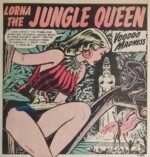 Werner Roth’s Lorna is set in a dark and shadowy jungle, with very effective use of light and shade, a highly imaginative design and style, and a fluidity which belies the stiffness of his later work (as by Jay Gavin) on Marvel’s X-Men. Lorna herself is beautiful, but somehow darkly ethereal and belongs in this jungle world. (Our resident fashion guru, Dr. Evilla, when she was preparing the scans for this article, wondered where Lorna got her hair done and wants the address of that jungle hairdresser.)
Werner Roth’s Lorna is set in a dark and shadowy jungle, with very effective use of light and shade, a highly imaginative design and style, and a fluidity which belies the stiffness of his later work (as by Jay Gavin) on Marvel’s X-Men. Lorna herself is beautiful, but somehow darkly ethereal and belongs in this jungle world. (Our resident fashion guru, Dr. Evilla, when she was preparing the scans for this article, wondered where Lorna got her hair done and wants the address of that jungle hairdresser.)
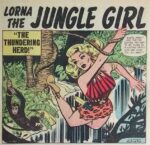 Jay Scott Pike’s style was quite different; his jungle was lighter and the art seemed more two-dimensional, lacking the depth and perspective of Roth, but still very competent, with Lorna just as lovely, if somewhat less dark. The tone of the series remained the same, with Rico still scripting.
Jay Scott Pike’s style was quite different; his jungle was lighter and the art seemed more two-dimensional, lacking the depth and perspective of Roth, but still very competent, with Lorna just as lovely, if somewhat less dark. The tone of the series remained the same, with Rico still scripting.
The very final story, in Lorna #26, sees our heroine in the big city and wearing a dress, with Greg assuring her that ‘this is where you belong, Lorna… not in the jungle!’ Following a harrowing rooftop adventure with an escaped ‘night beast’ (part ape, part lion and all demon), Lorna emerges victorious and the creature is captured to be returned to the jungle where it belongs, according to the police. Lorna suggests to Greg that they do too, and Greg has to admit that Lorna is right at last: ‘Back we go!’ And we assume that’s what they did. For Lorna never appeared again. For all we know, she and Greg are there still, in their love/hate relationship, keeping the jungle safe from all manner of stuff.
 Finally, a word about the covers. Neither Roth nor Pike were ever trusted with them, Atlas preferring a whole range of different cover artists: Carl Burgos (including #1), Christopher Rule, Al Hartley, Russ Heath, Harry Anderson, Syd Shores, Joe Maneely, Al Williamson, Vince Colletta and, for five of the last six issues, the wonderful Bill Everett, producing the best artwork on the entire series. We make no apologies for reproducing all five of his covers at the end of this article. A great pity that Everett never got to draw the insides. Although, he kinda did. In Riot #6 (June 1956), Atlas’s Mad-like parody series, Stan Lee himself scripted Loona, the Jungle Girl, a three page pastiche with art by Bill Everett; what might have been (sigh…).
Finally, a word about the covers. Neither Roth nor Pike were ever trusted with them, Atlas preferring a whole range of different cover artists: Carl Burgos (including #1), Christopher Rule, Al Hartley, Russ Heath, Harry Anderson, Syd Shores, Joe Maneely, Al Williamson, Vince Colletta and, for five of the last six issues, the wonderful Bill Everett, producing the best artwork on the entire series. We make no apologies for reproducing all five of his covers at the end of this article. A great pity that Everett never got to draw the insides. Although, he kinda did. In Riot #6 (June 1956), Atlas’s Mad-like parody series, Stan Lee himself scripted Loona, the Jungle Girl, a three page pastiche with art by Bill Everett; what might have been (sigh…).
Still, there’s no denying the appeal of the Lorna series. Less violent and with much better art than the Fox jungle characters, more charm and wit than the Fiction House and Nedor ones, Lorna is my favourite jungle girl.
Rob Rudderham, May 2020
Lockdown Interlude Week 6
We’re back again with more scribblings on stuff from our personal collections to fill our time until we can bring you our regular newsletters with stock updates again. We’re glad that so many of you seem to be enjoying these interludes, and we’ll try to keep up with occasional features after we’re back trading again. In the meantime, keep well and stay safe!
The ‘WandaMySister’ Years: Best. Avengers. Ever!
In early 1961, Stan Lee was reputedly asked by his publisher, Martin Goodman, to produce a comic book similar to DC’s Justice League of America, a team formed of DC’s major superhero characters, which was going great guns on the nation’s newsstands. Trouble was, Lee’s company – not then known at that point as Marvel Comics – didn’t have any major superhero characters. They had had, back in the 1940s and 1950s, but even their biggest stars – Captain America, the Sub-Mariner and the Human Torch – had been cancelled twice each, and Lee was reluctant to revisit the well for a third attempt. Instead he reinvented the superhero format, creating a dysfunctional family, the Fantastic Four, and, battening on to their success, more hits followed – Spider-Man, Iron Man, Thor – so that, a couple of years later, Lee was in a position to create a team of his major heroes, a true equivalent to DC’s Justice League.
The Avengers, launched in 1963, teamed up Iron Man, Thor, the Hulk and Ant-Man & the Wasp, each of whom was the star of their own solo series. Replacing the early-departing Hulk, whose first run was a surprising flop for Marvel, was Captain America in issue #4, reintroducing the Golden Age hero and giving him a ‘Man Out Of Time’ vibe which resonated with the readership more strongly than a straight revival would have. This stellar team had several epic adventures, and seemed set confidently to rival the JLA in sales and power – but then, with #16, Lee moved the goalposts yet again!
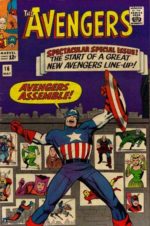 In issue #16, entitled ‘The Old Order Changeth’, Lee sacked four-fifths of the team; it’s easy to see why: Hank & Jan were written out – their strip in Tales to Astonish, having been bitten by a radioactive sales report, was about to be cancelled. But Thor and Iron Man were huge hits, so perhaps Lee (at that stage writing everything, rather than the multiple author & editor set-up over at DC) wanted to focus more on their solo adventures without the distraction of their involvement in the Avengers. In any event, Thor, Iron Man, Giant-Man and the Wasp were replaced by three reformed villains – Hawkeye, who had battled Iron Man on numerous occasions, and Quicksilver & the Scarlet Witch, sibling enemies of the X-Men. It was a ballsy move in story context; Hawkeye was a known thief and Petro and Wanda, recently members in good standing of the Brotherhood of Evil Mutants, were terrorists owing to their association with Magneto. Would the readers accept them as heroes?
In issue #16, entitled ‘The Old Order Changeth’, Lee sacked four-fifths of the team; it’s easy to see why: Hank & Jan were written out – their strip in Tales to Astonish, having been bitten by a radioactive sales report, was about to be cancelled. But Thor and Iron Man were huge hits, so perhaps Lee (at that stage writing everything, rather than the multiple author & editor set-up over at DC) wanted to focus more on their solo adventures without the distraction of their involvement in the Avengers. In any event, Thor, Iron Man, Giant-Man and the Wasp were replaced by three reformed villains – Hawkeye, who had battled Iron Man on numerous occasions, and Quicksilver & the Scarlet Witch, sibling enemies of the X-Men. It was a ballsy move in story context; Hawkeye was a known thief and Petro and Wanda, recently members in good standing of the Brotherhood of Evil Mutants, were terrorists owing to their association with Magneto. Would the readers accept them as heroes?
It was also a daring move commercially; Iron Man and Thor’s presence would have been a huge ‘crossover’ draw to readers. Replacing them with three virtual unknowns – mentored by the remaining Captain America, whose solo feature in Tales of Suspense was less than a year old, and still unproven – could have resulted in the title’s swift demise. Instead, it provided a more intimate dynamic. Freed from the concern of having to co-ordinate the Avenging activities with the solo series, Lee could concentrate more on the character interplay which was his strength. ‘Cap’s Kookie Quartet’ became a faux family a la the Fantastic Four, bickering but loyal to each other, with Hawkeye and Quicksilver butting heads to be the young alpha of the pack, while gradually, in tiny stages, the Scarlet Witch emerged from her brother’s shadow, growing in power and confidence.
 There were flaws, of course; Hawkeye’s constant Johnny-One-Note abrasiveness, ameliorated only occasionally, could become annoying when read in large doses, and Quicksilver’s arrogance begged to be punctured (as well as his inability to address his sister Wanda without adding the explanatory suffix ‘my sister’ – as if either of them was likely to forget that fact! (Granted, Marvel did, but that was decades later…)). And while the Scarlet Witch did come forward during this time, the statement has to be qualified by the observation that it was the early 1960s, and ‘baby steps’ were the order of the day. There were glimpses of her potentially devastating powers, but sadly most of the time, it was still a man telling her when and how to use them. That being said, her effortless takedown in issue #18 of a villain who had defeated all her male colleagues was gratifying.
There were flaws, of course; Hawkeye’s constant Johnny-One-Note abrasiveness, ameliorated only occasionally, could become annoying when read in large doses, and Quicksilver’s arrogance begged to be punctured (as well as his inability to address his sister Wanda without adding the explanatory suffix ‘my sister’ – as if either of them was likely to forget that fact! (Granted, Marvel did, but that was decades later…)). And while the Scarlet Witch did come forward during this time, the statement has to be qualified by the observation that it was the early 1960s, and ‘baby steps’ were the order of the day. There were glimpses of her potentially devastating powers, but sadly most of the time, it was still a man telling her when and how to use them. That being said, her effortless takedown in issue #18 of a villain who had defeated all her male colleagues was gratifying.
Above it all, there was the guiding presence of Captain America, shown not as the gung-ho patriot of his vintage iteration, but as a parental figure, training his protégés, but also evidently caring for them. A man cut away from his own era, the younger Avengers became Cap’s surrogate for the family he might otherwise have had in a kinder world, and it’s a tribute to Lee’s skill as a writer that Cap’s unspoken parental love (tempered with impatience!) for his charges shone through.
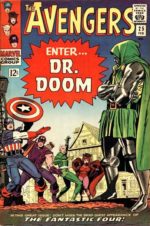 This team’s first objective was to locate and recruit the Hulk, as, lacking the raw power of Thor, Iron Man and Giant-Man, they felt somewhat challenged. But their skills and powers, plus instinctive teamwork, proved more than sufficient to their goals, and the idea of Hulk-wrangling was abandoned by the newly-confident quartet. Together, they faced down some of the Avengers’ greatest enemies: the Enchantress and the Executioner, the villain first known as Power Man, traitorous new recruit the Swordsman, time-travelling tyrant Kang, and the Marvel Universe’ ‘Biggest Bad’, Doctor Doom!
This team’s first objective was to locate and recruit the Hulk, as, lacking the raw power of Thor, Iron Man and Giant-Man, they felt somewhat challenged. But their skills and powers, plus instinctive teamwork, proved more than sufficient to their goals, and the idea of Hulk-wrangling was abandoned by the newly-confident quartet. Together, they faced down some of the Avengers’ greatest enemies: the Enchantress and the Executioner, the villain first known as Power Man, traitorous new recruit the Swordsman, time-travelling tyrant Kang, and the Marvel Universe’ ‘Biggest Bad’, Doctor Doom!
 Stan became a little restless with a ‘second FF’, however, and by issue #26, he began expanding the roster; in that issue, Janet Van Dyne, the Wasp, sought the Avengers’ help, and her size-changing sweetheart followed along soon after, under a new nom du guerre of Goliath. Both rejoined the team, and the cast of characters was expanded further after Roy Thomas took over the scripting with the addition of Hercules, on one of those temporary exiles from paradise that comic-book gods are so fond of. Brash and overwhelming, but benign, Herc filled the ‘raw power’ requirement admirably, while maintaining the focus on interpersonal relationships. And ‘Cap’s Kookie Quartet’ became an effective octet with the increasing involvement of the Black Widow, who had graduated from Iron Man’s femme fatale to Hawkeye’s romantic interest. A bad girl gone good, Natasha’s shadowed past amped up the drama and angst even as she fought alongside the team – her non-Avenger status proving pivotal to the group’s survival at one point. This mix of characters, tensions, and romantic subplots kept the audience enthralled and the sales up without the ‘star power’ of the marquee names.
Stan became a little restless with a ‘second FF’, however, and by issue #26, he began expanding the roster; in that issue, Janet Van Dyne, the Wasp, sought the Avengers’ help, and her size-changing sweetheart followed along soon after, under a new nom du guerre of Goliath. Both rejoined the team, and the cast of characters was expanded further after Roy Thomas took over the scripting with the addition of Hercules, on one of those temporary exiles from paradise that comic-book gods are so fond of. Brash and overwhelming, but benign, Herc filled the ‘raw power’ requirement admirably, while maintaining the focus on interpersonal relationships. And ‘Cap’s Kookie Quartet’ became an effective octet with the increasing involvement of the Black Widow, who had graduated from Iron Man’s femme fatale to Hawkeye’s romantic interest. A bad girl gone good, Natasha’s shadowed past amped up the drama and angst even as she fought alongside the team – her non-Avenger status proving pivotal to the group’s survival at one point. This mix of characters, tensions, and romantic subplots kept the audience enthralled and the sales up without the ‘star power’ of the marquee names.
Sadly, it didn’t endure. Roy Thomas decided to shake matters up in a major way, and with issue #47, Quicksilver and the Scarlet Witch were forcibly recruited by Magneto again – with a head injury to Wanda subsequently rendering her powerless and amnesiac for a tedious subplot. Other characters were introduced in rapid succession – the heroic version of the Black Knight, the Black Panther, the Vision – as the Avengers changed once more, from an intimate ensemble cast with a ‘chosen family’ feel to an association of like-minded colleagues with common goals.
There were many cracking issues in the title’s future, the quality not significantly diminishing until past #100, but the unique dynamic established in #16, while sustainable through cautious expansion, didn’t survive the free for all come’n’go which began with #47.
Recommended issues: Avengers #16 to #46, Annual #1.
Will Morgan, April 2020
Reina M. Bull – Mystery 1950s SF Illustrator
I remember coming across the illustrations of Reina M Bull in Brian Aldiss’s lavish 1975 book ‘Science Fiction Art’, wherein two of her magazine covers were reproduced in much larger than life size, almost A3. Both were highly stylised and, as Aldiss put it, carried ‘high sexual charges’. 45 years on, I know little more about her than I did then (which was nothing), but it was probably due to those illustrations in that book that she is chiefly remembered today.
Reina M Bull (born Sington) lived from 1924-2000, but appears only to have been active as an illustrator after the end of the Second World War up to the early 1950s. Ironically, her four covers for New Worlds and Science Fantasy (the British Nova science fiction magazines), as well as being her only entries in the genre, appear to be her last work published. Like her more famous contemporary, Reginald Heade, little is known of her life.

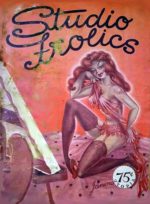

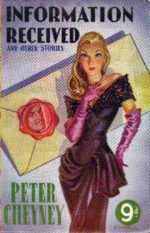 Her early illustrations (as Reina Sington) were for fairy tale books, then later mainly crime covers. Included at this time were works by Agatha Chrstie, Peter Cheyney and Edgar Allan Poe. Later still she provided covers for Mens’ Magazines from Utopia Press with titles like Heebee Jeebee, Hula Hotcha, Fads and Fancies and many others. These were credited as by Janine, presumably to protect her anonymity.
Her early illustrations (as Reina Sington) were for fairy tale books, then later mainly crime covers. Included at this time were works by Agatha Chrstie, Peter Cheyney and Edgar Allan Poe. Later still she provided covers for Mens’ Magazines from Utopia Press with titles like Heebee Jeebee, Hula Hotcha, Fads and Fancies and many others. These were credited as by Janine, presumably to protect her anonymity.
Which brings us to her science fiction covers, all reproduced below. From left to right: New Worlds Autumn 1951 & November 1952, and Science Fantasy Winter 1951/52 & Spring 1952. Both New Worlds and Science Fantasy went on to become the flagship magazines of the British new wave of science fiction in the 1960s, as exemplified by Aldiss, Ballard, Moorcock and many others, but back in the 1950s, edited by John Carnell, they were the British equivalents of the American pulps so prevalent for decades.
Reina Bull had a fluidity of her characters and an angular geometry of her machines and buildings which combined to provide memorable images, typifying the retro futuristic vibe I’ve mentioned in these pages before. The colours are vivid and her people have an alien, almost elfin look. I’ve found the images have stayed with me since I first saw them; perhaps they have a hypnotic or hallucinogenic quality ten or more years ahead of their time. Buyers of these issues will be as delighted as I was when I acquired them to find many interior illustrations by her as well.
If you’re lucky, these can be found still at a few pounds each, a relatively small price to pay for a unique set of classic science fiction art, which only leaves us regretting that Reina Bull didn’t go on to produce more.
Rob Rudderham, April 2020












